Blues alley
murals
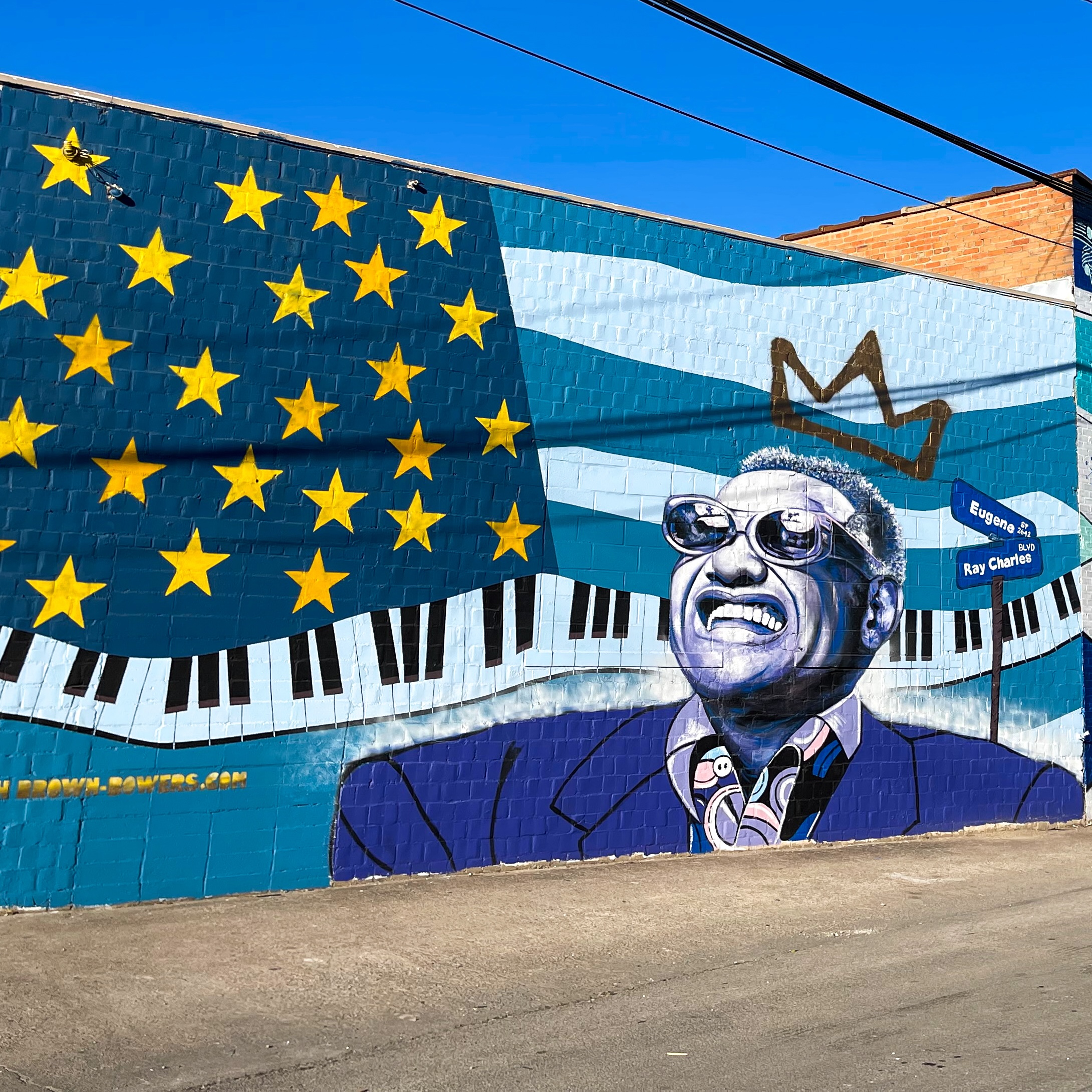
Ray Charles
by Sanah Brown Bowers
Sanah Brown Bowers @sanahbrownbowers | Clover Street & South Crowdus Street
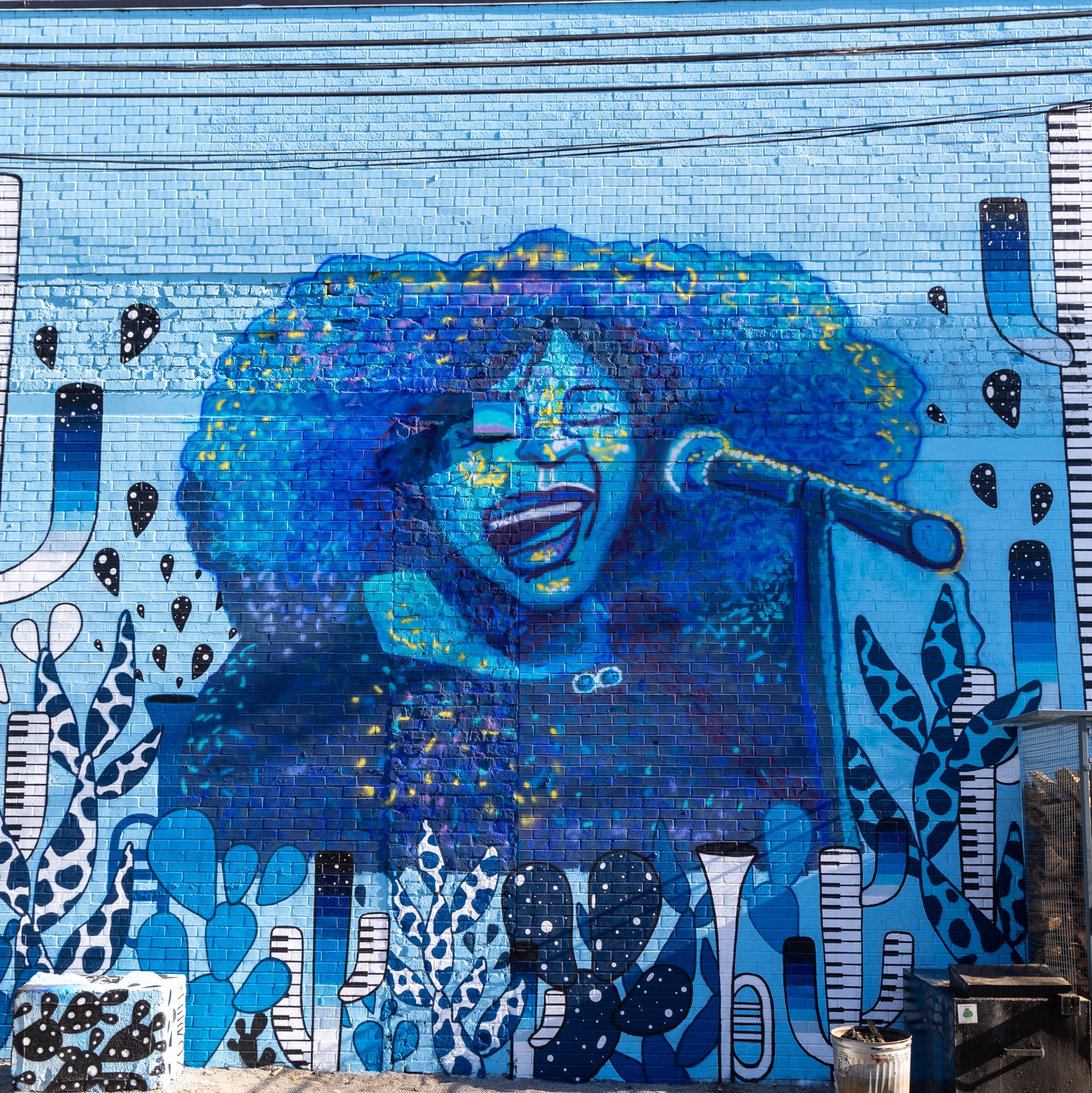
Wanda King
by Lashonda Cooks
“Wanda King is a force. Her voice. Her candor. Her majesty as she leads her band -- she's one of few female bandleaders.
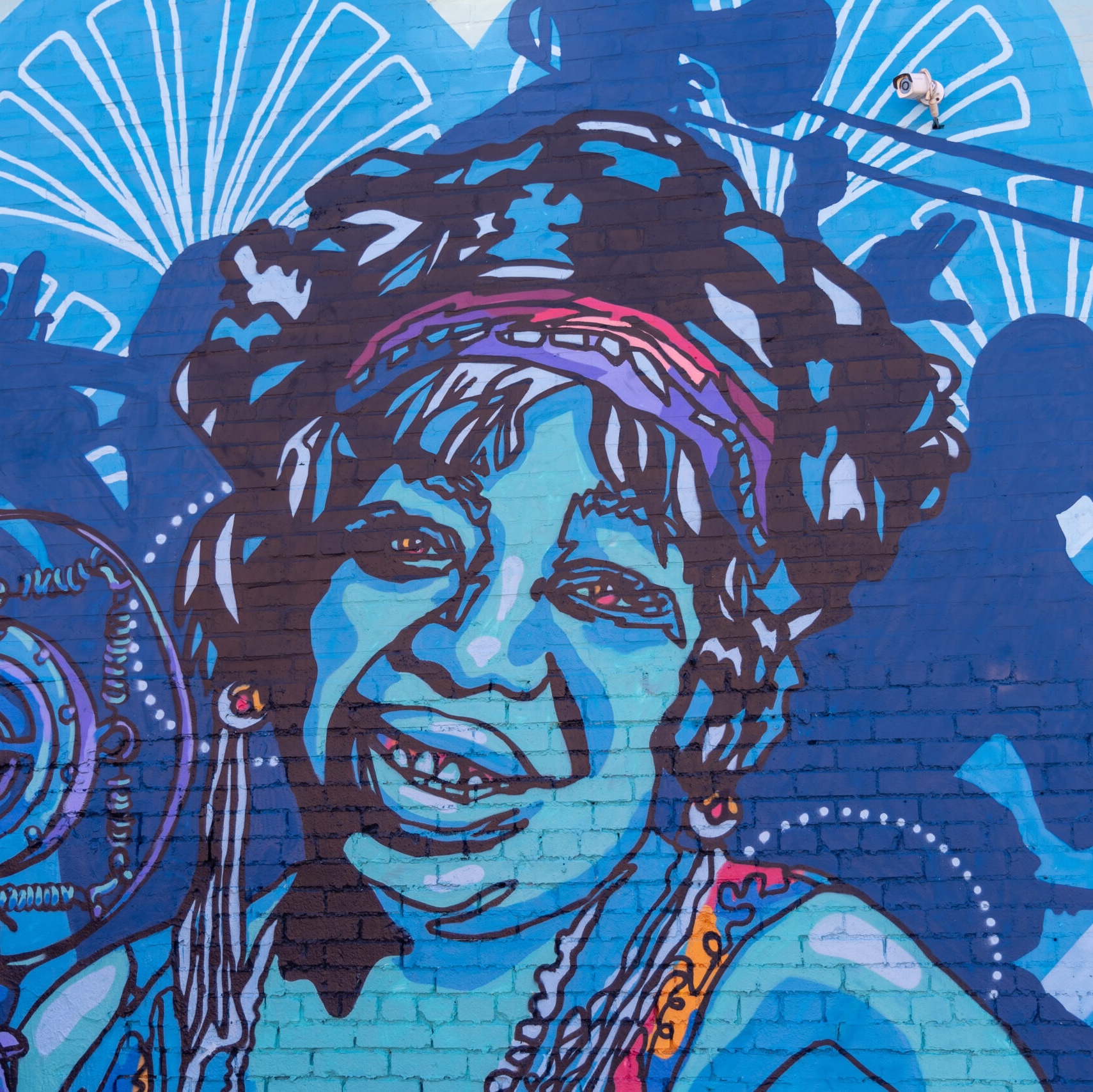
Ma Rainey
by Michelle Dekkers
When people discuss the birth of blue music, and more specifically Deep Ellum blues, the first and sometimes only names mentioned are those of men
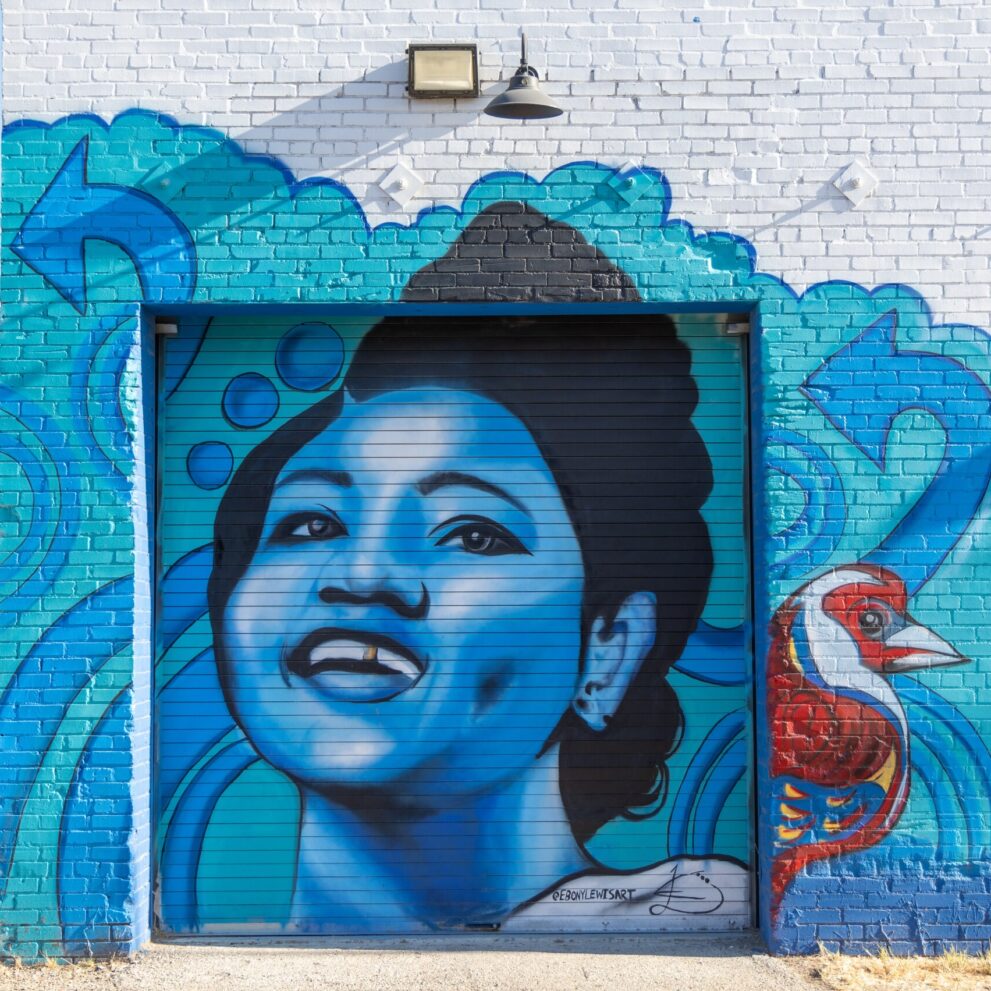
"Mo'Betta Blue" Boom Box Graphic
by Ebony Lewis
This work speaks to the transition and evolution of blues music and how its influences are still relevant to this day.
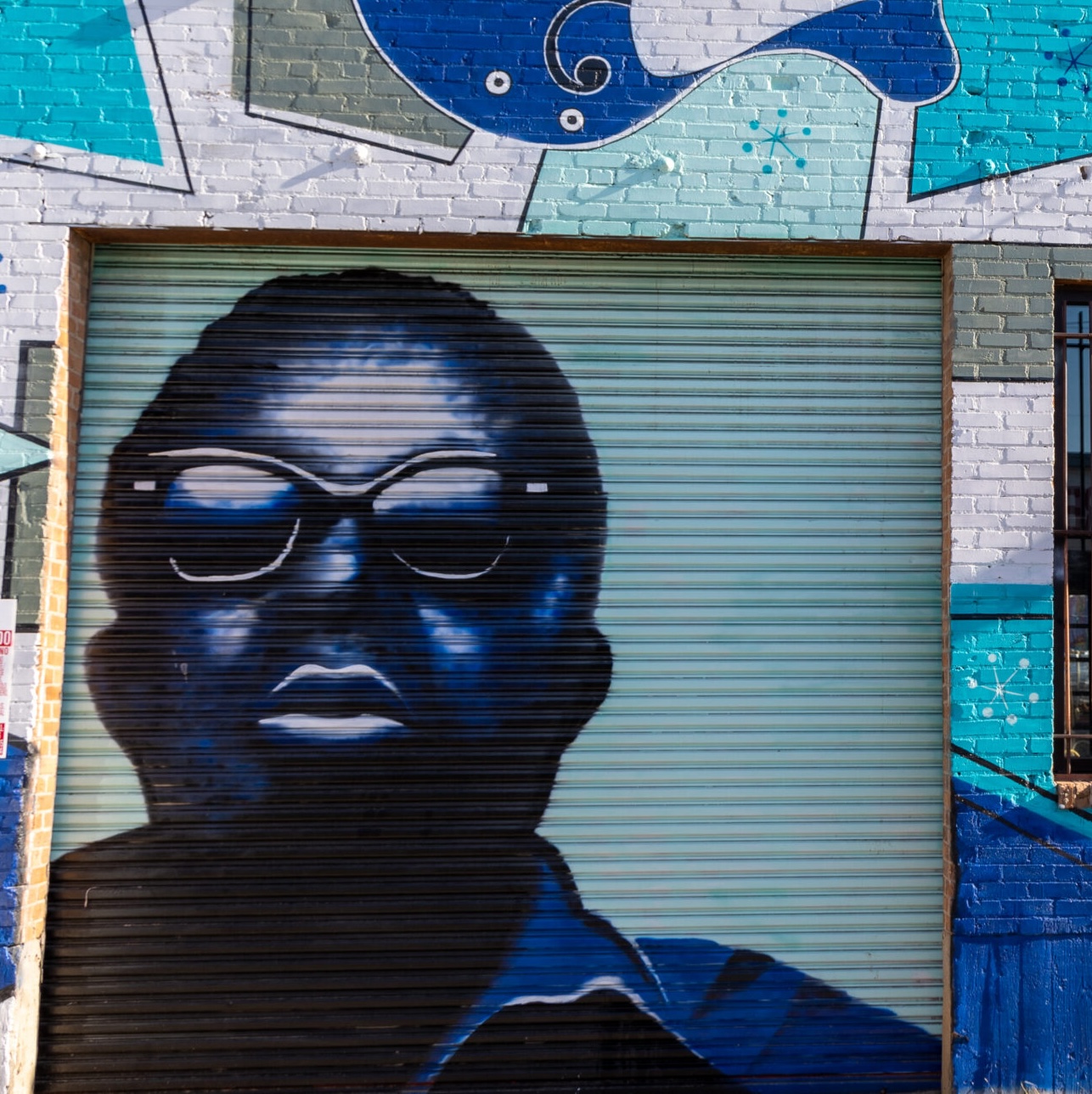
Sam Meyer
by Frank Campagna
Frank Campagna | Clover Street & South Crowdus Street
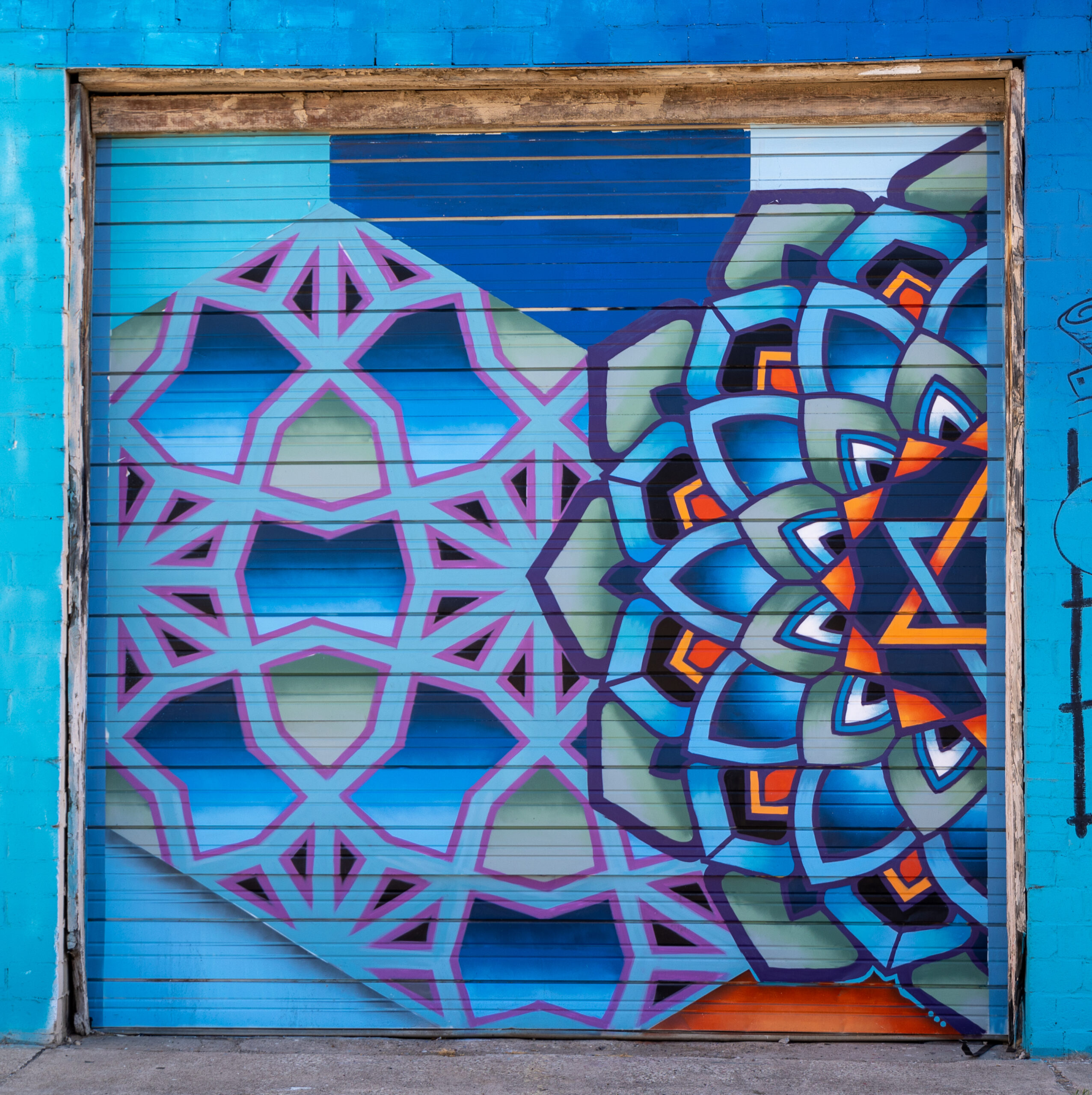
Pattern
by Brandon Ephraim Berrios
Berrios's work has designs in harmony with a large mandala with an abstract pattern in background.
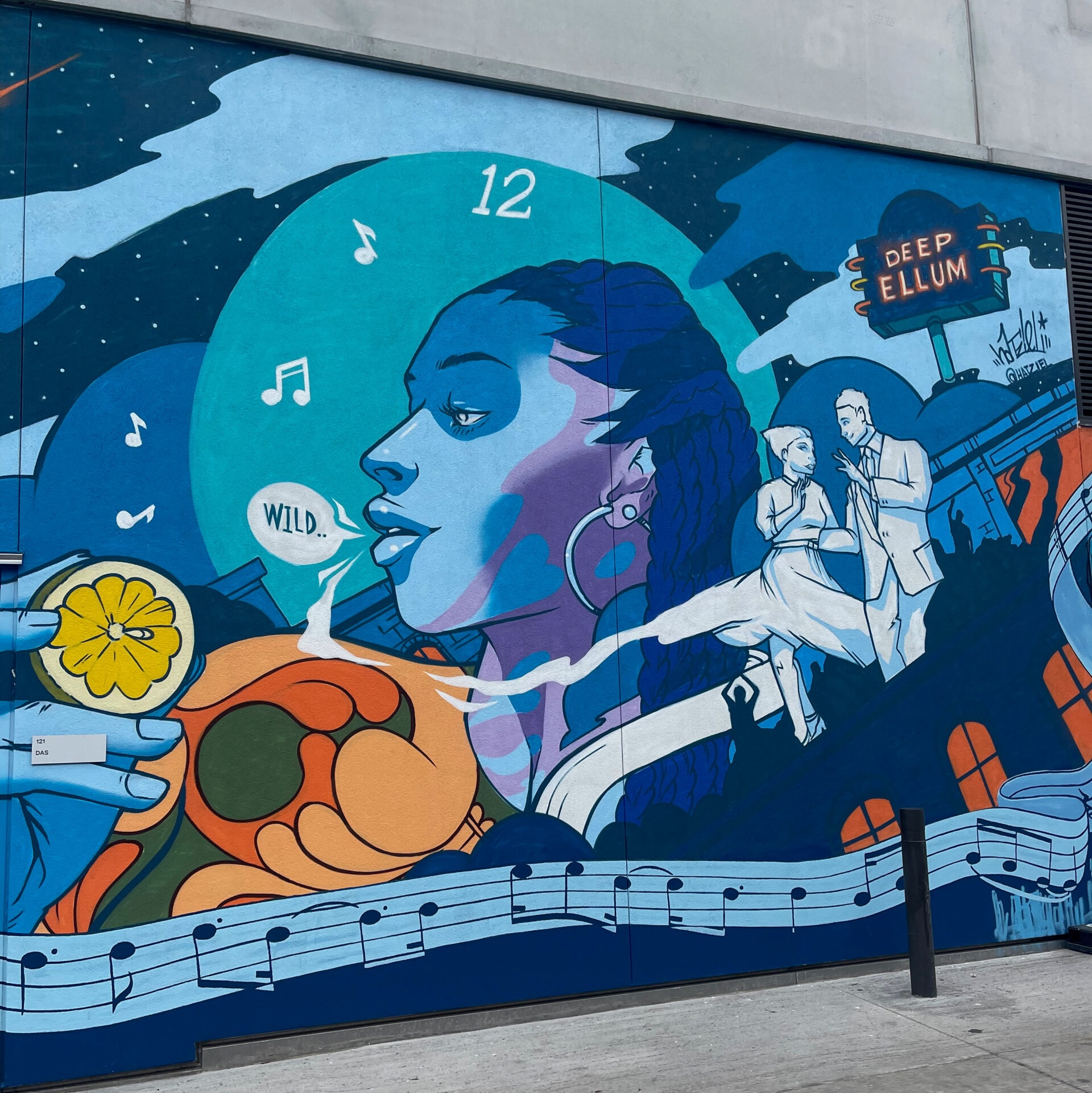
"Big Night Blues" A Blind Lemon song depicted
by Hatziel Flores
Hatziel Flores @hatziel | Clover Street & Henry Street
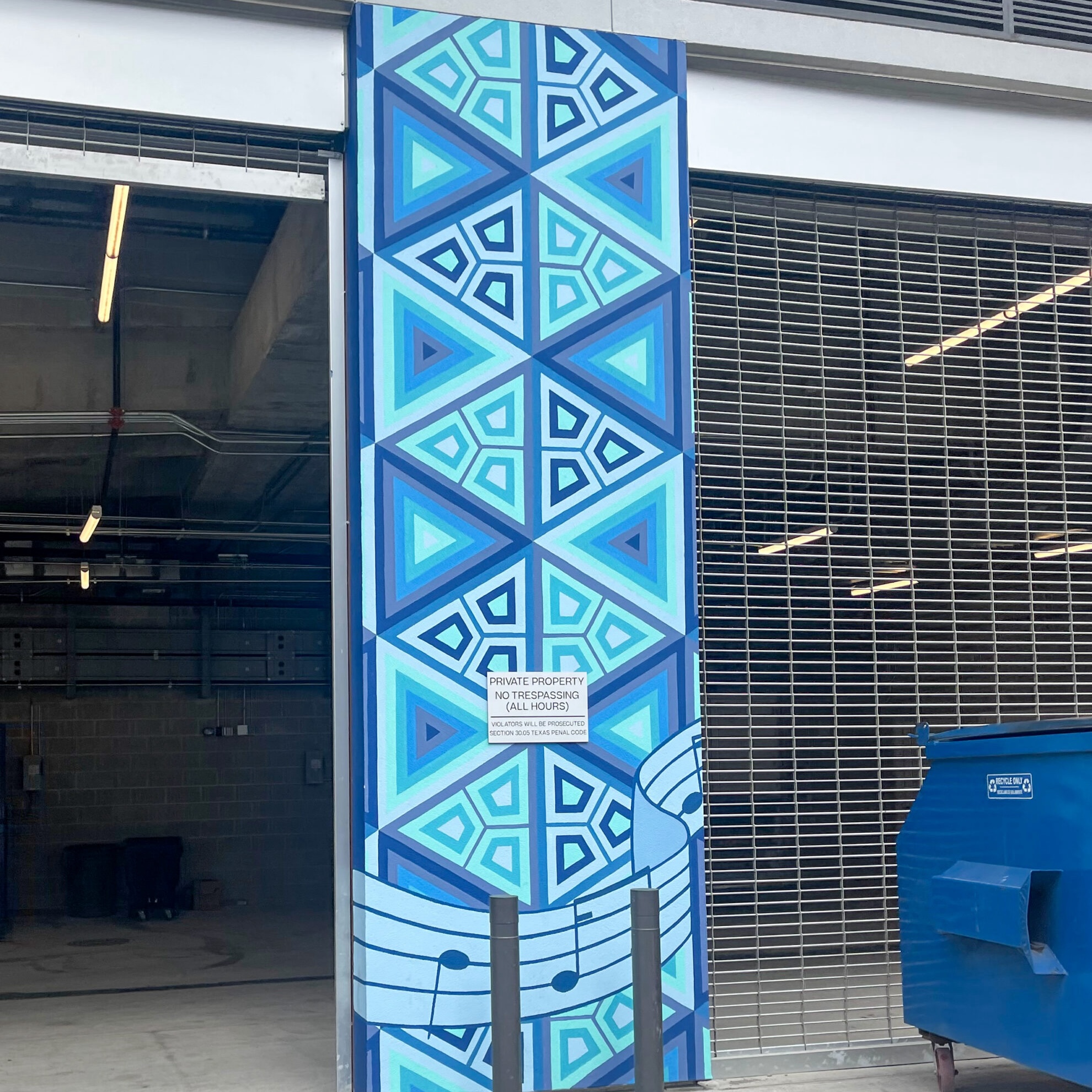
"Triadic Triblu” African fabric-inspired pattern
by Jody Aderhold
This is a modern twist on a tribal pattern, ...
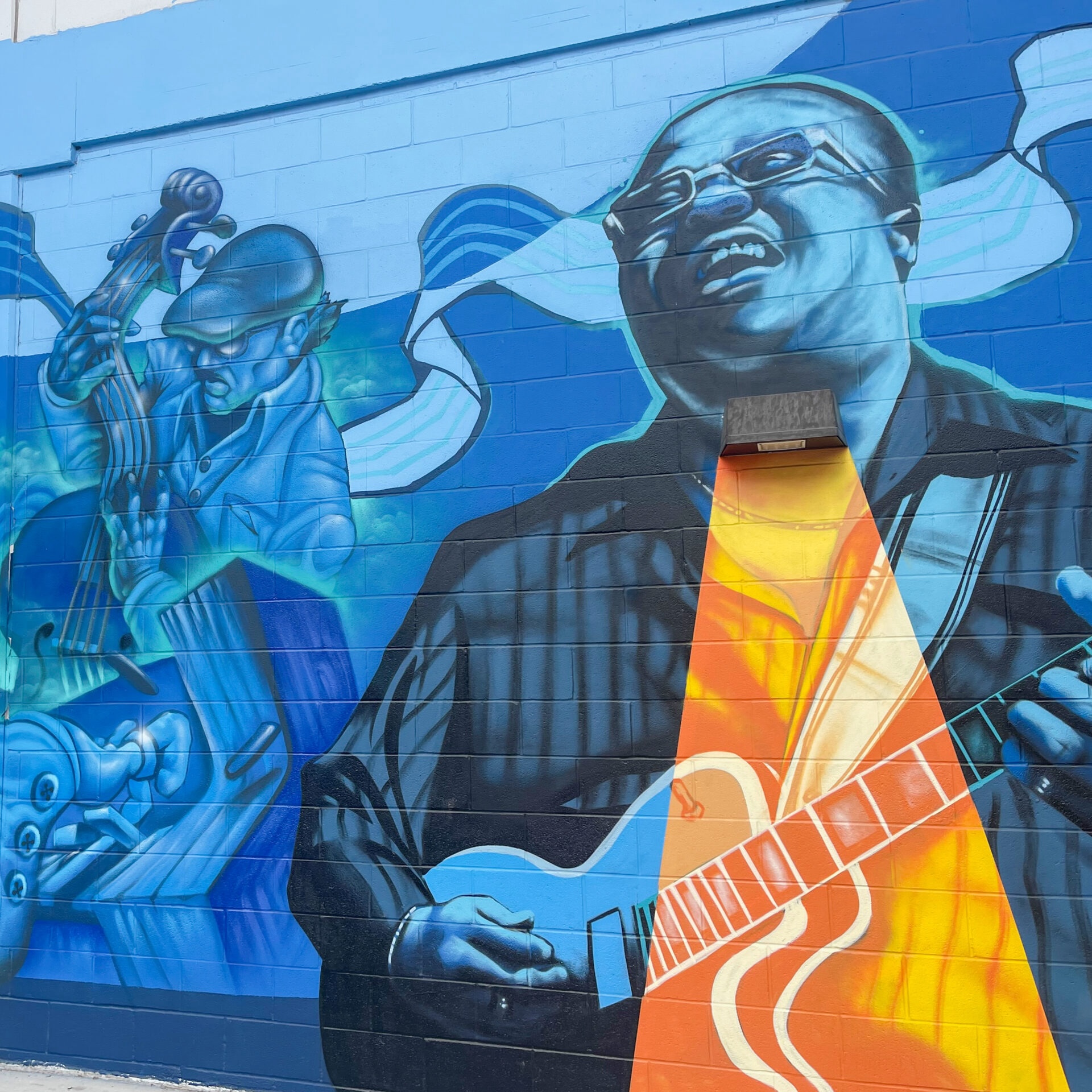
"Jam Session" Andrew "JrBoy" Jones & Zuzu Bollin
by Hatziel Flores, Ray Albares, Joe Skillz
This mural is a jam session, both for the artists depicted and the artist who painted them
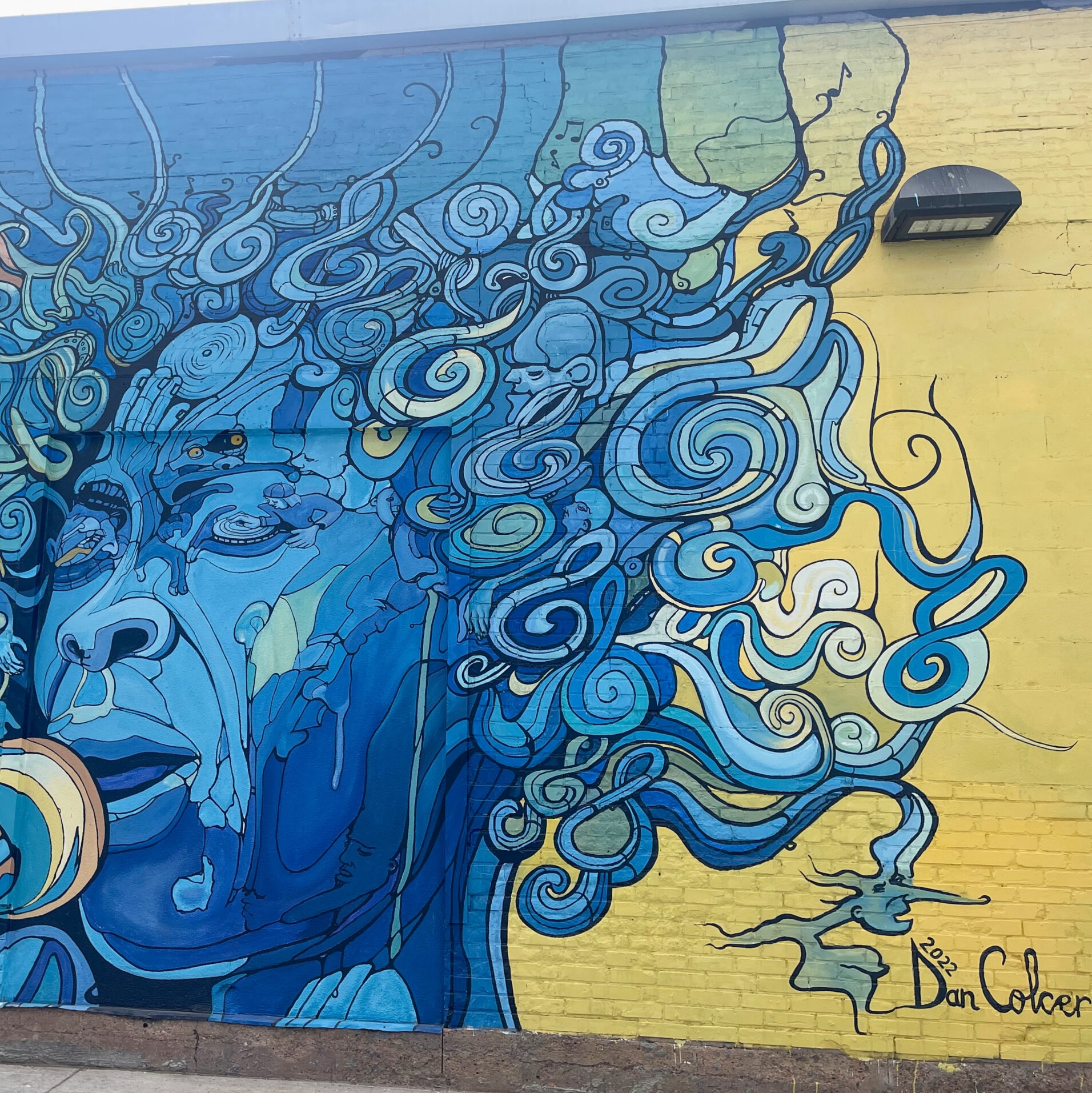
Erykah Badu
by Dan Colcer
Dan Colcer @dcolcerart | Clover Street & Henry Street
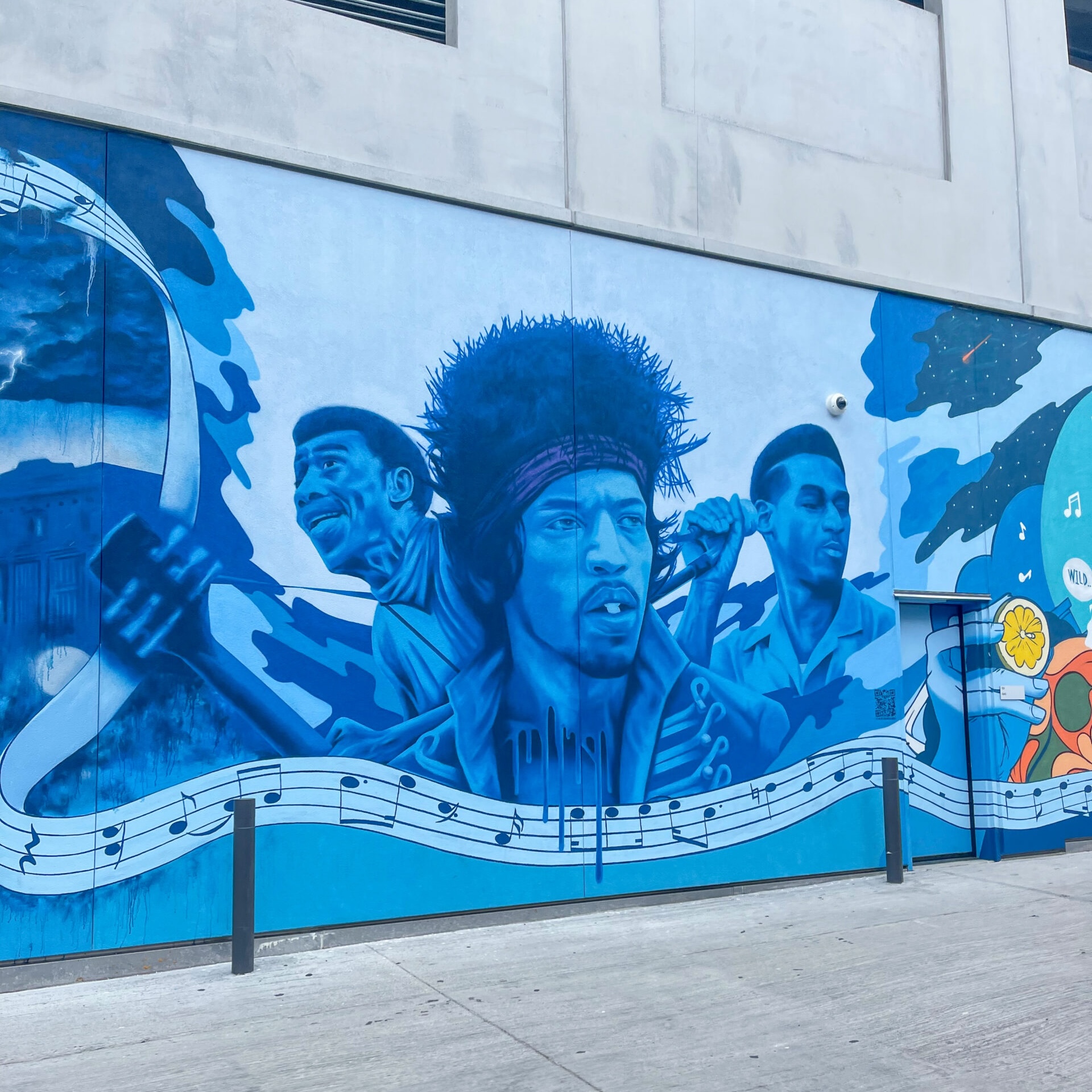
"Of Ellum" Aaron T-Bone Walker, Jimi Hendrix, Leon Bridges
by Alfredo Pina
Alfredo Pina @1amthewalrus | Clover Street & Henry Street
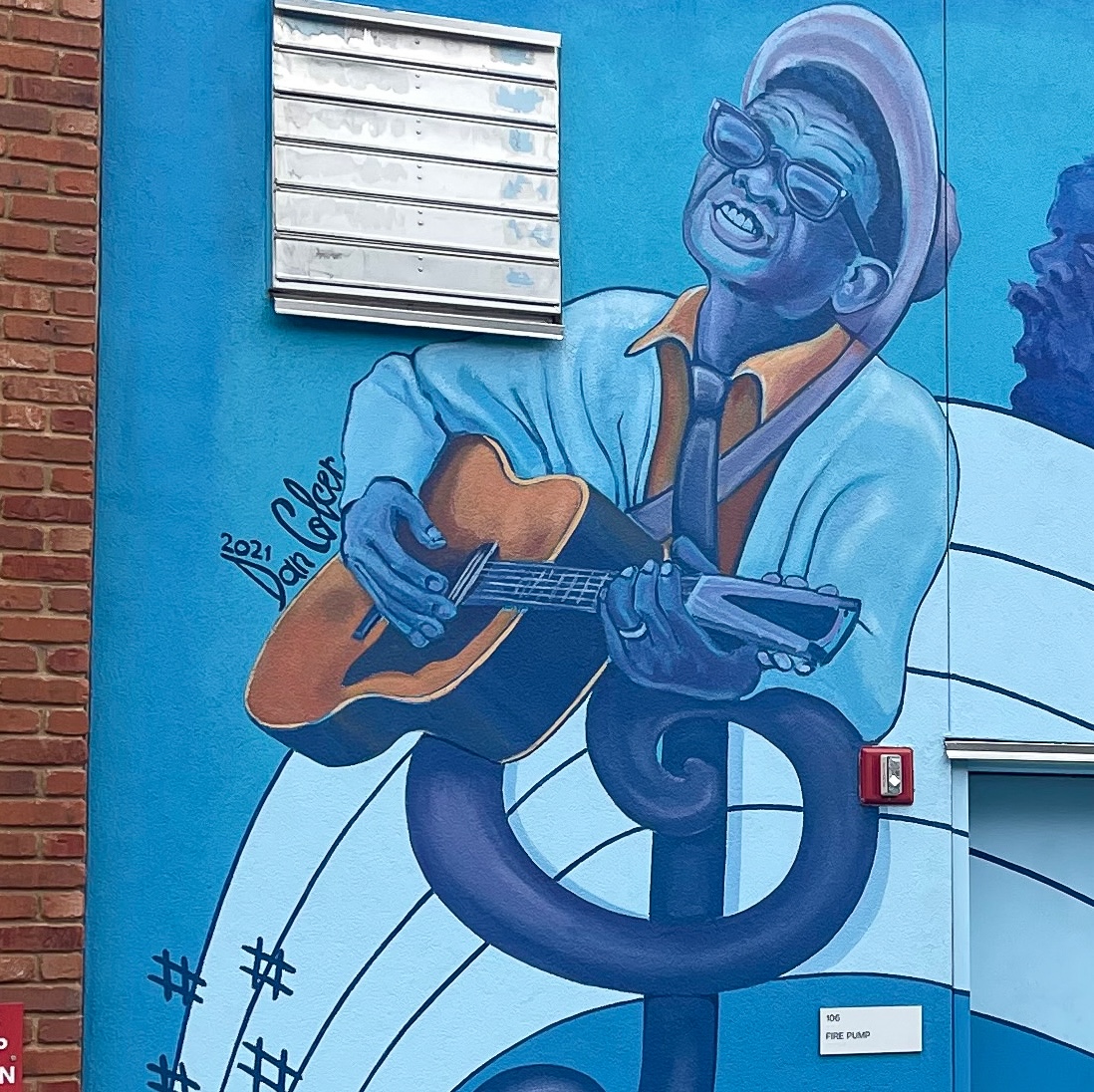
Lightnin Hopkins
by Dan Colcer
The opener of the Blues Alley, Texas Sam Lightnin’ Hopkins sits in the starting position of the murals at the back of the Stack building.
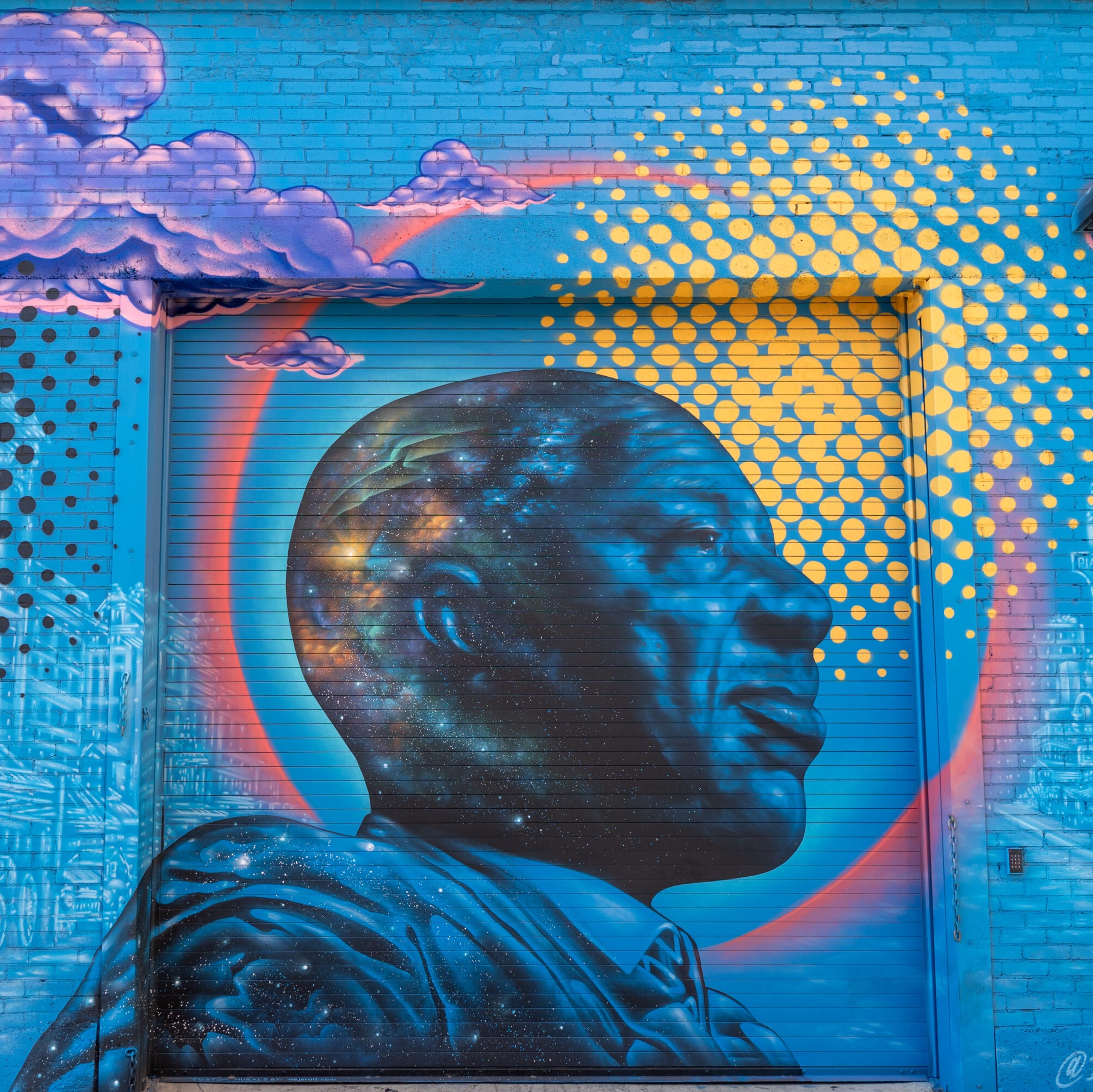
Lonnie Johnson
by Jerod Davies
Jerod Davies @dtoxart | Clover Street & South Crowdus Street
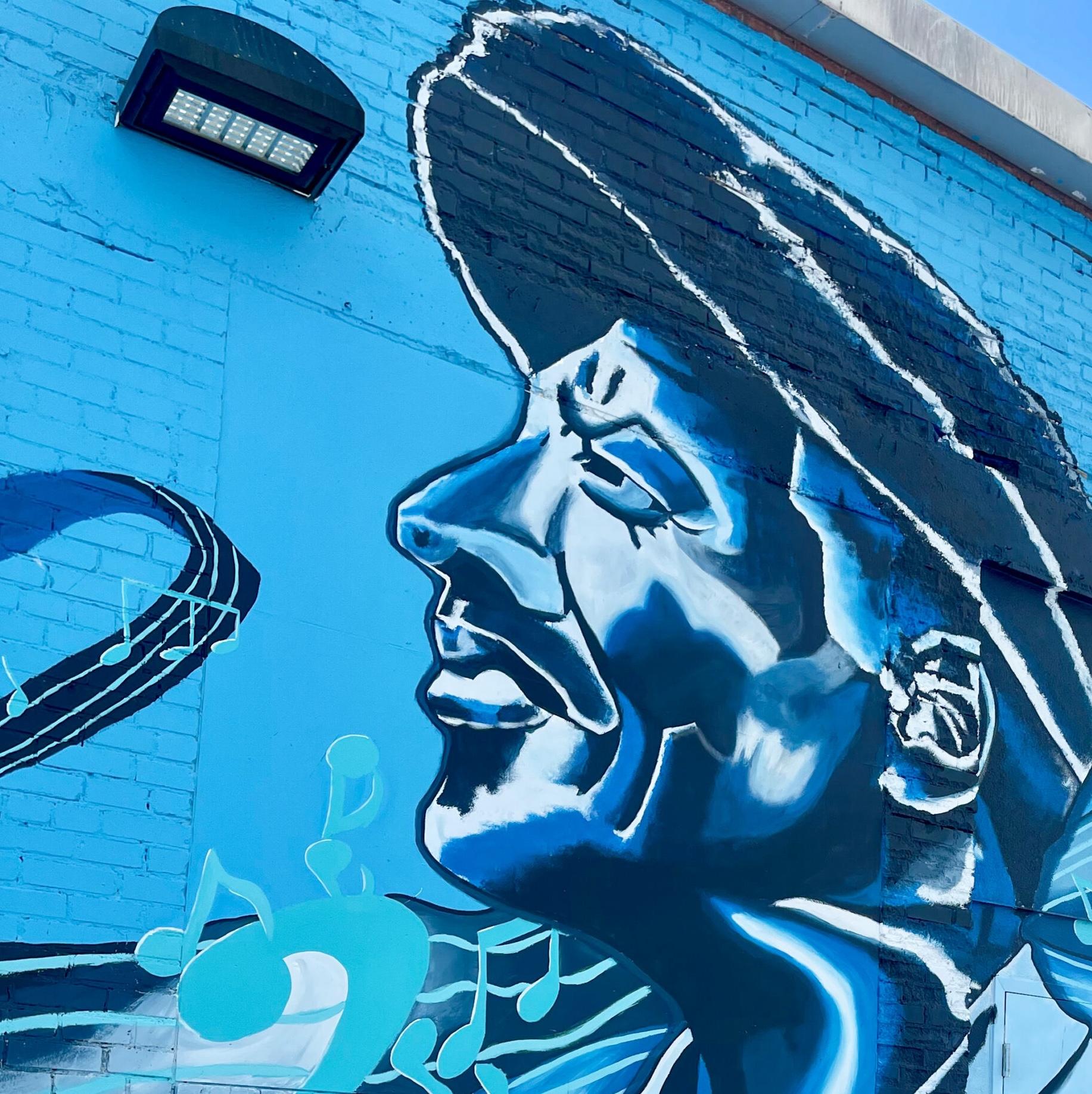
Whistlin' Alex Moore
by Martell Holloway
"Dallas artist ""Whistlin"" Alex Moore was an American blues singer, pianist and whistler.
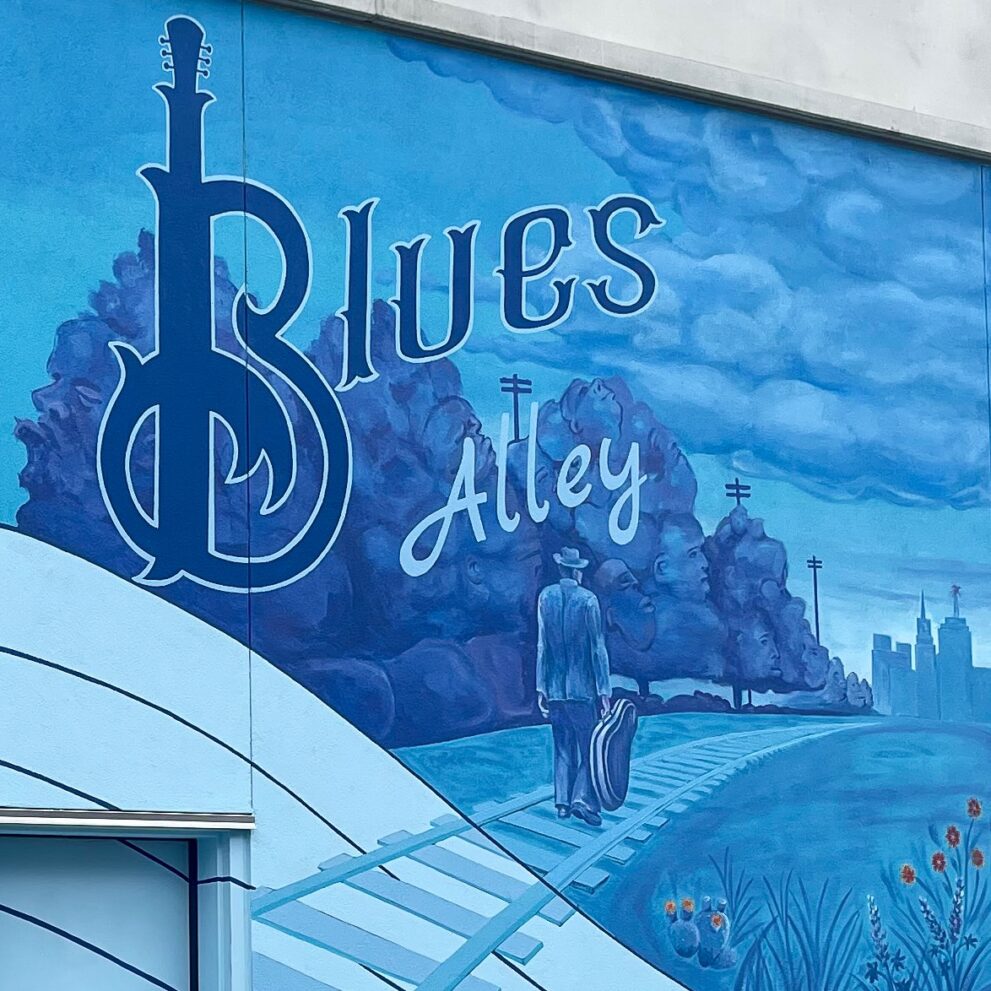
Musician walking down the Central Track to Dallas
by Cathryn Colcer
The piece includes the Blues Alley logo at the top. Dan Colcer’s stylized trees and sky loom over a darkened view of a 1930s Dallas skyline
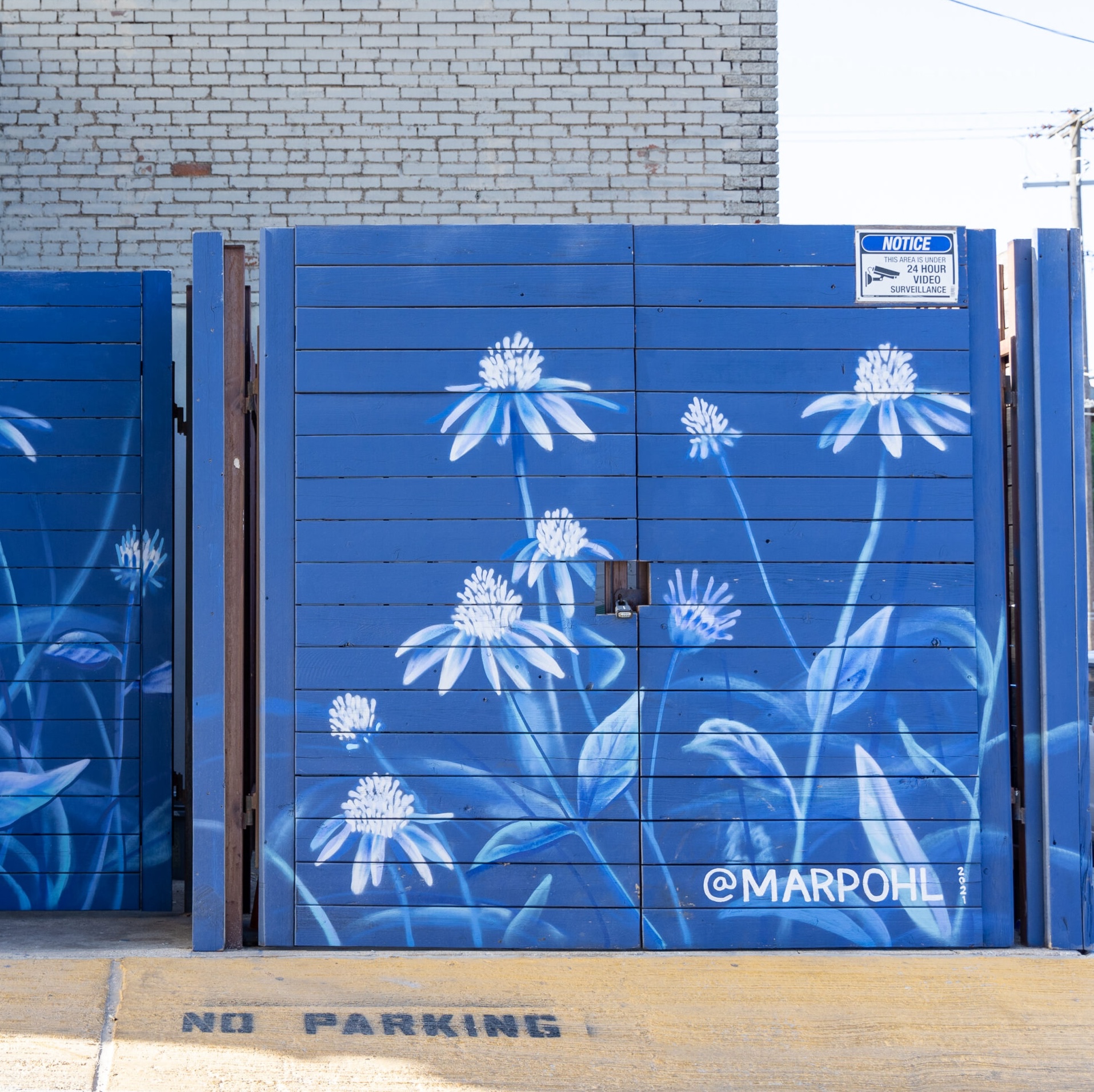
Blackland Prairie
by Mari Pohlman
Mari Pohlman @marpohl | Clover Street & Henry Street
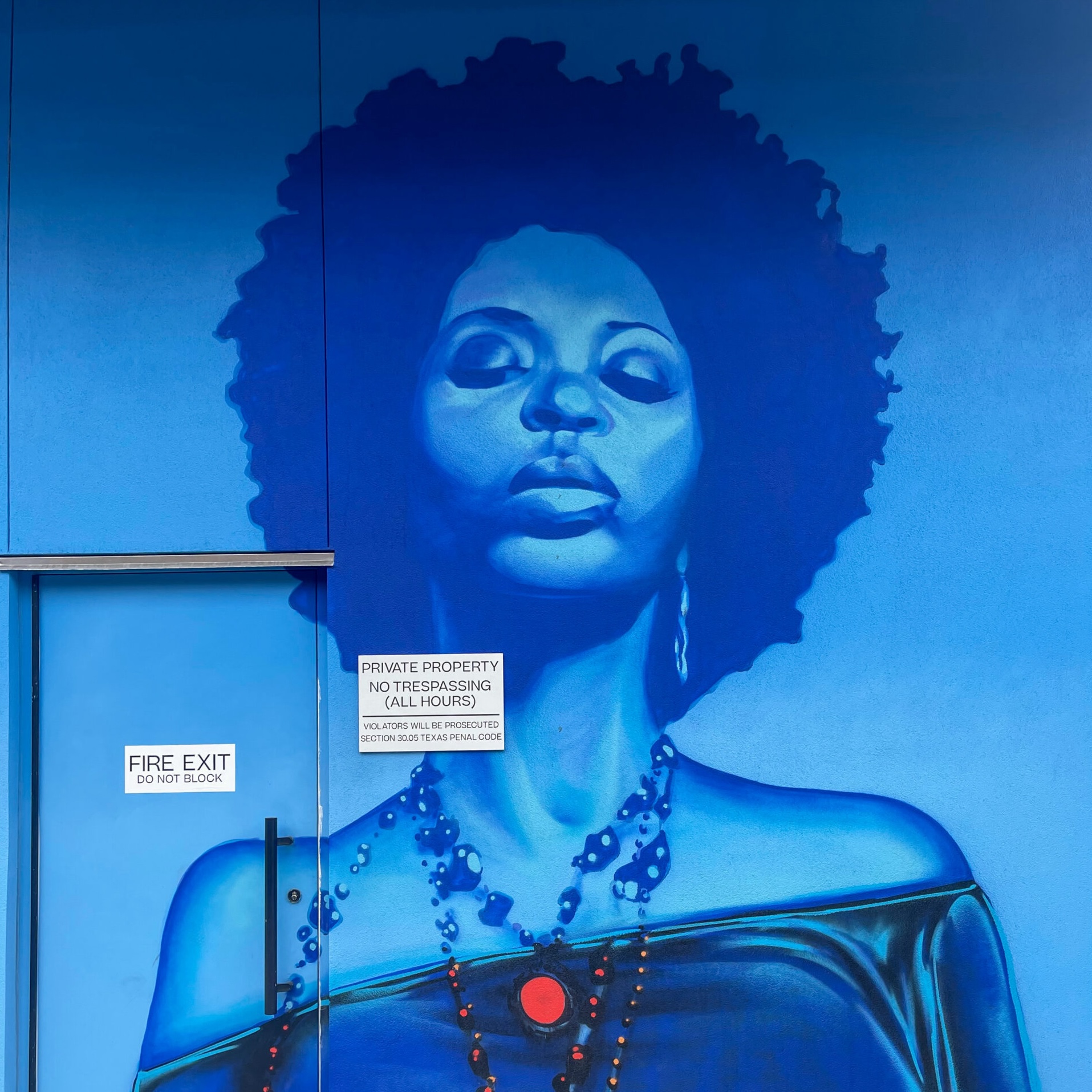
“N'Dambi Blue”
by Izk Davies
Izk Davies @izkart | Clover Street & South Crowdus Street
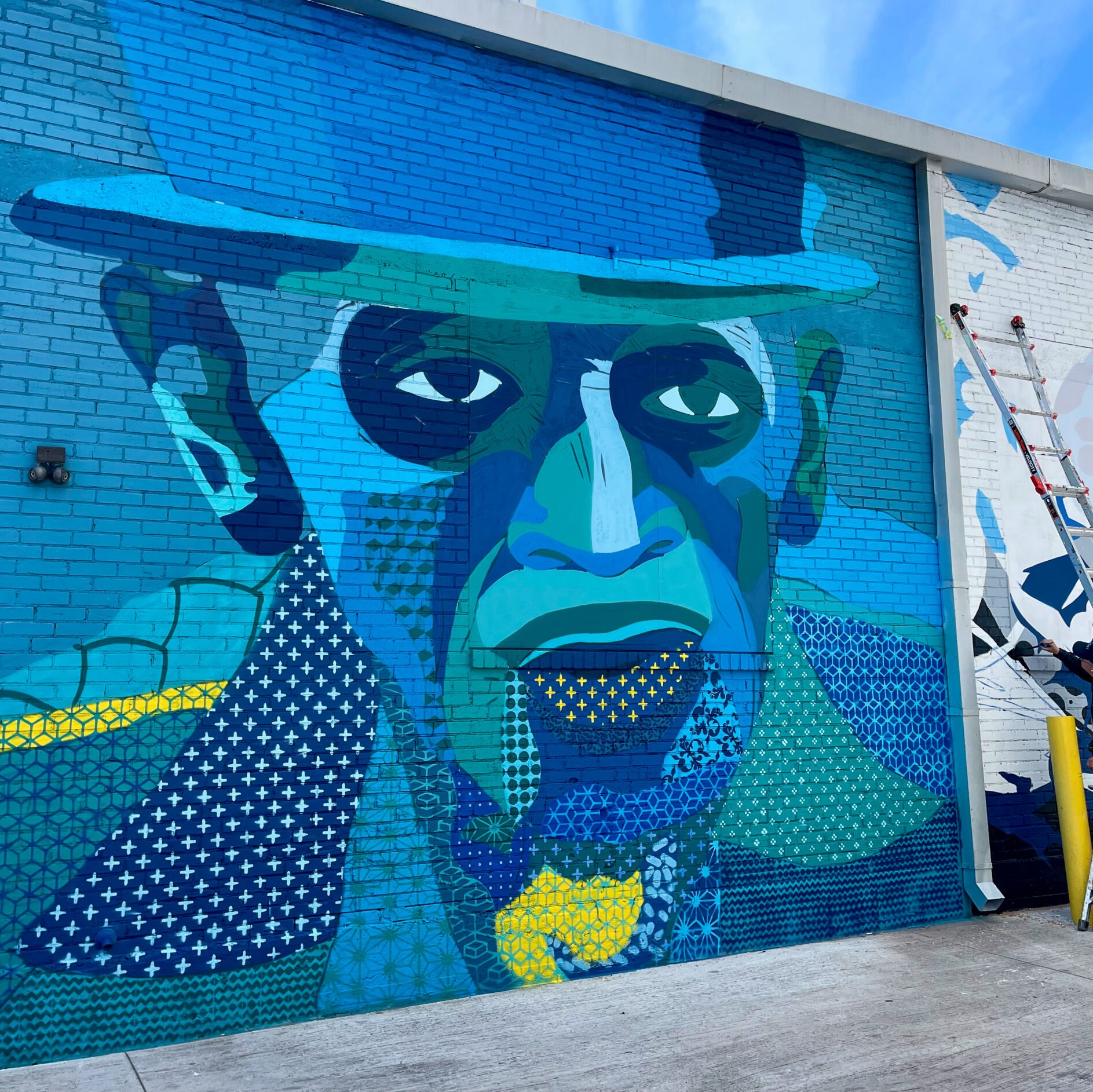
Mance Lipscomb
by Daniel Yanez
Yanez uses color and patterns to highlight Blues Player Mance Lipscomb
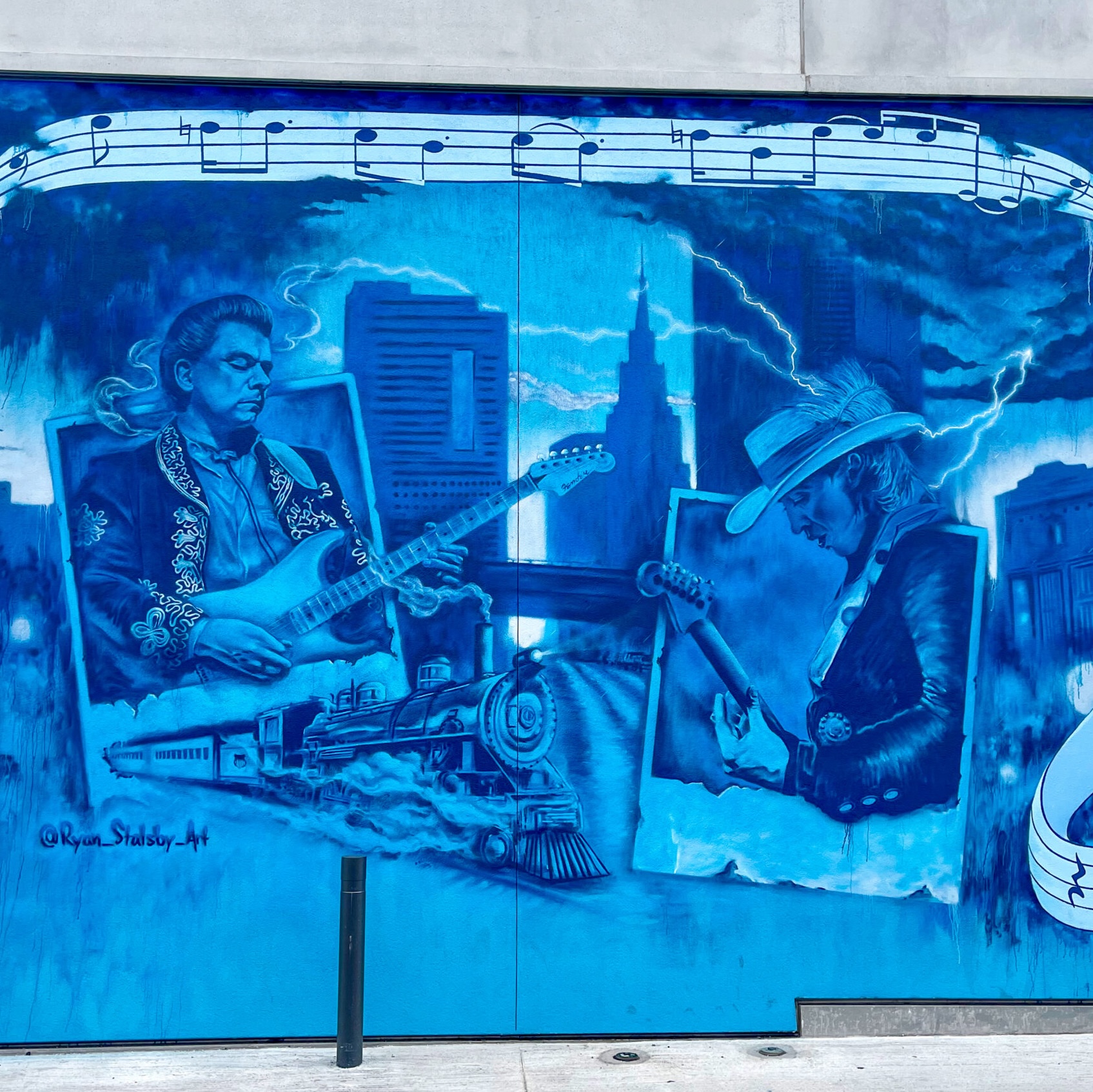
"Life by the Drop" Jimmy Lee and Stevie Ray Vaughn
by Ryan Stalsby
Life by The Drop is a mural honoring Dallas-born blues musicians and brothers Jimmie Vaughan and Stevie Ray Vaughan
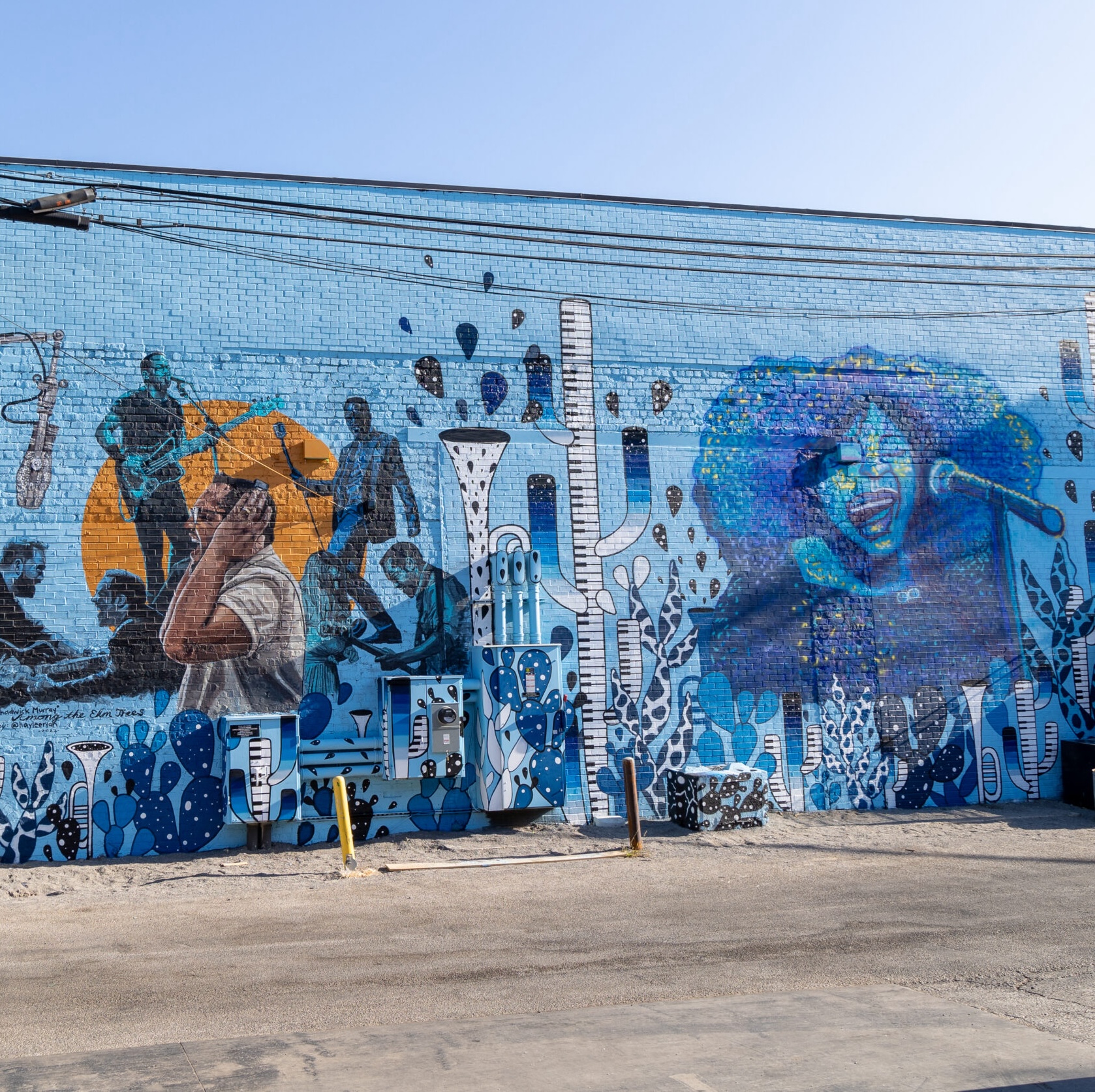
Cactus Royal Garden
by Will Heron
Reflecting on his Dallas roots, Will Heron's work often fuses southern imagery and shape illusions to create prickly, illustrative, high-contrast compositions
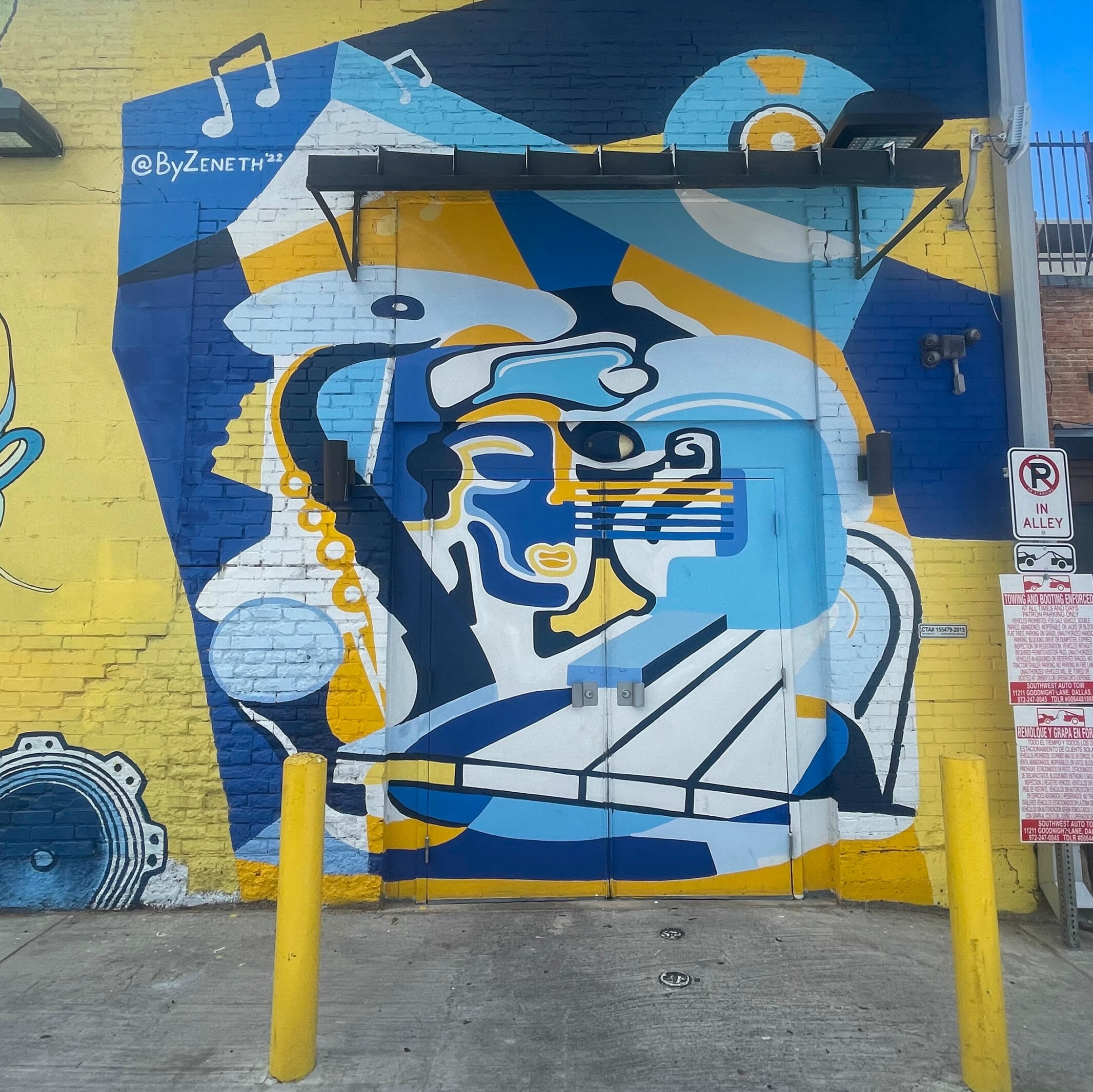
Musical Pattern
by Dora Reynosa
Reynosa created a man who is deconstructed to an extent.
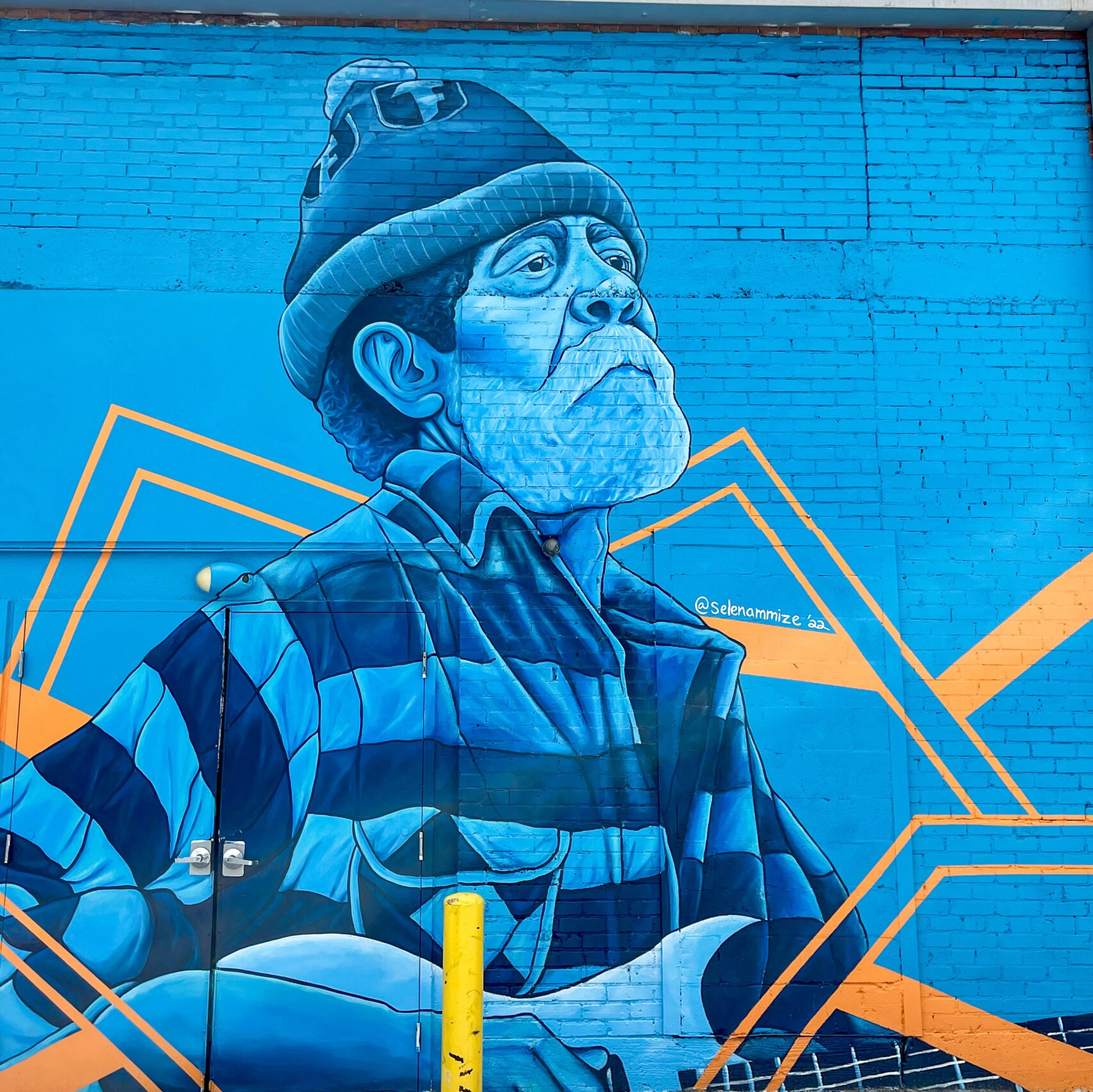
Henry Qualls
by Selena Mize
Selena Mize was told Henry Qualls was never without his guitar,
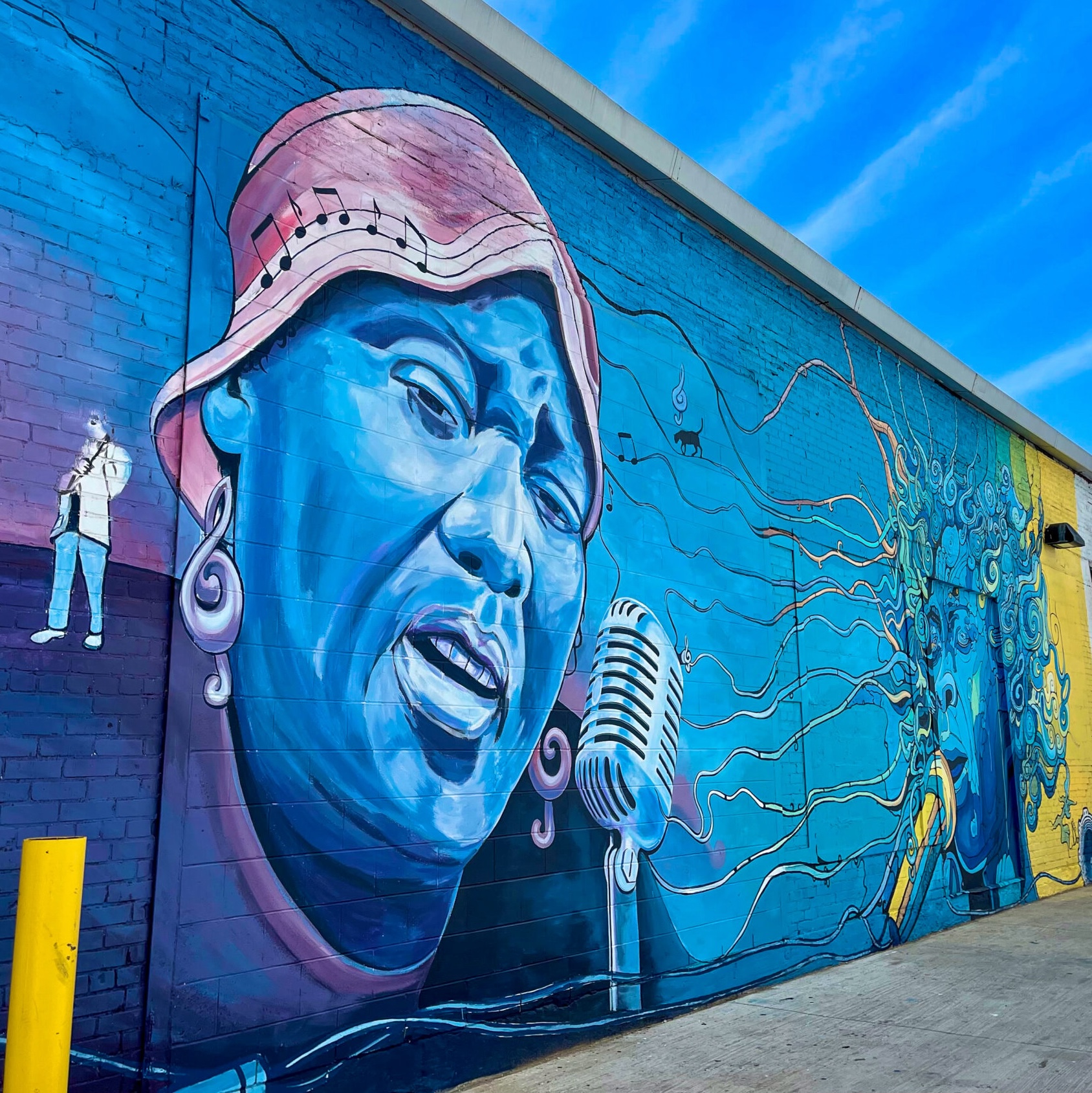
Bessie Smith
by Dan Colcer
Dan Colcer @dcolcerart
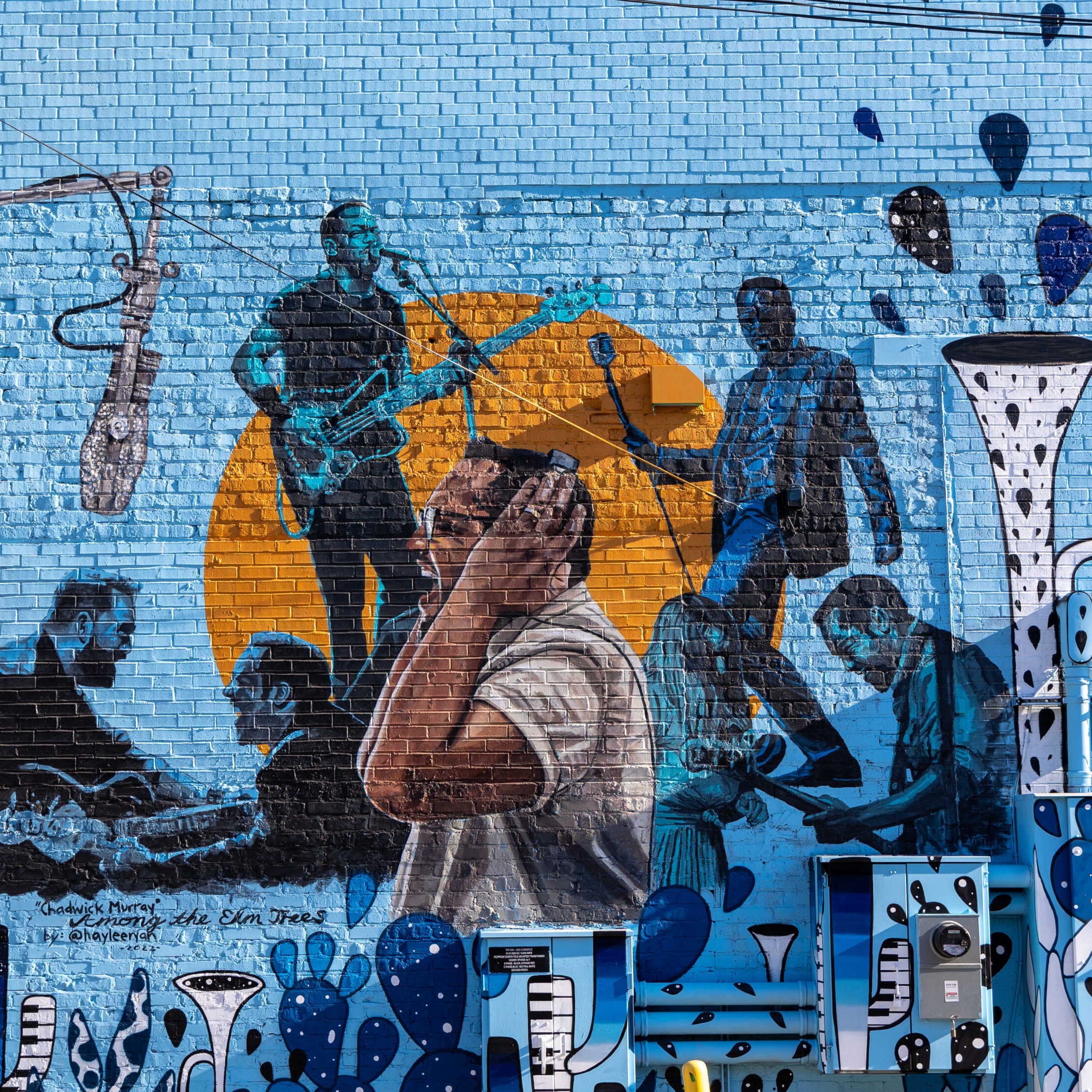
Chadwick Murray
by Haylee Ryan
Ryan painted her dear friend, band mate, local musician and all around good person, Chadwick Murray, who passed away Sept. 1, 202
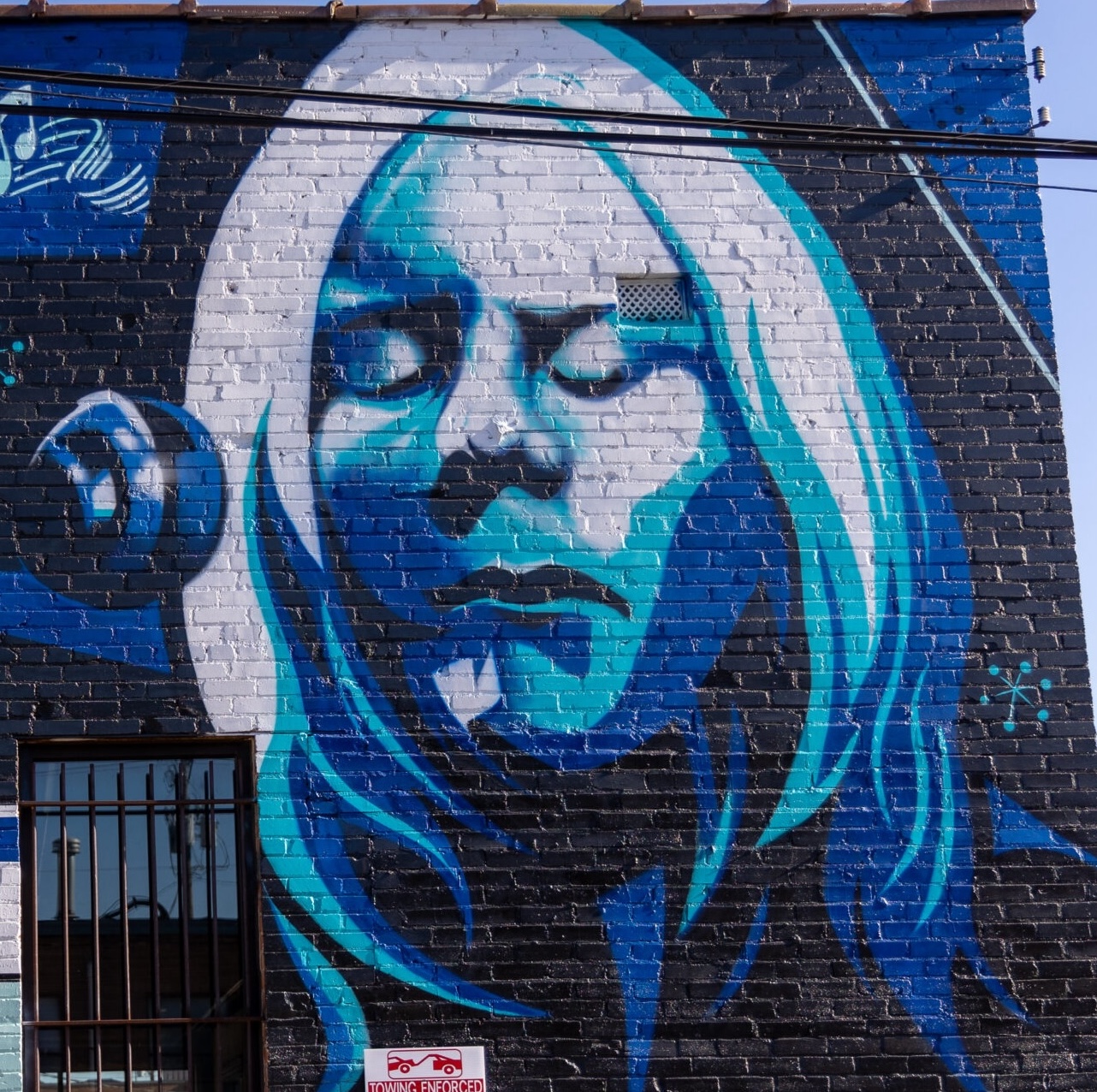
Johnny Winter
by Frank Campagna
Frank Campagna | Clover Street & South Malcolm X Blvd.
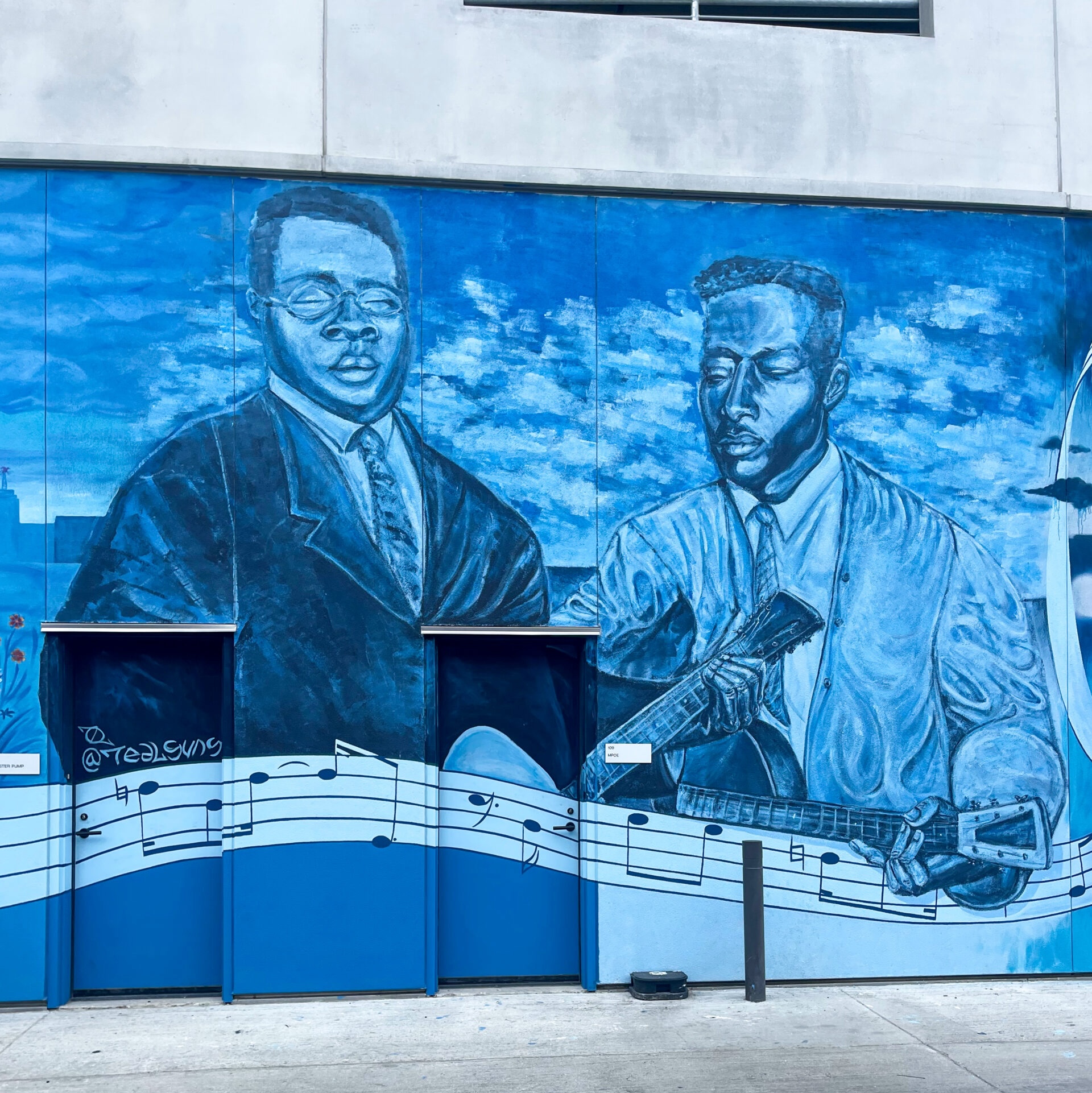
"Blues You Can Feel but Not See"
by Teal Suns
This mural is a double portrait of Texas Blues Artists Blind Lemon Jefferson and Blind Willie Johnson
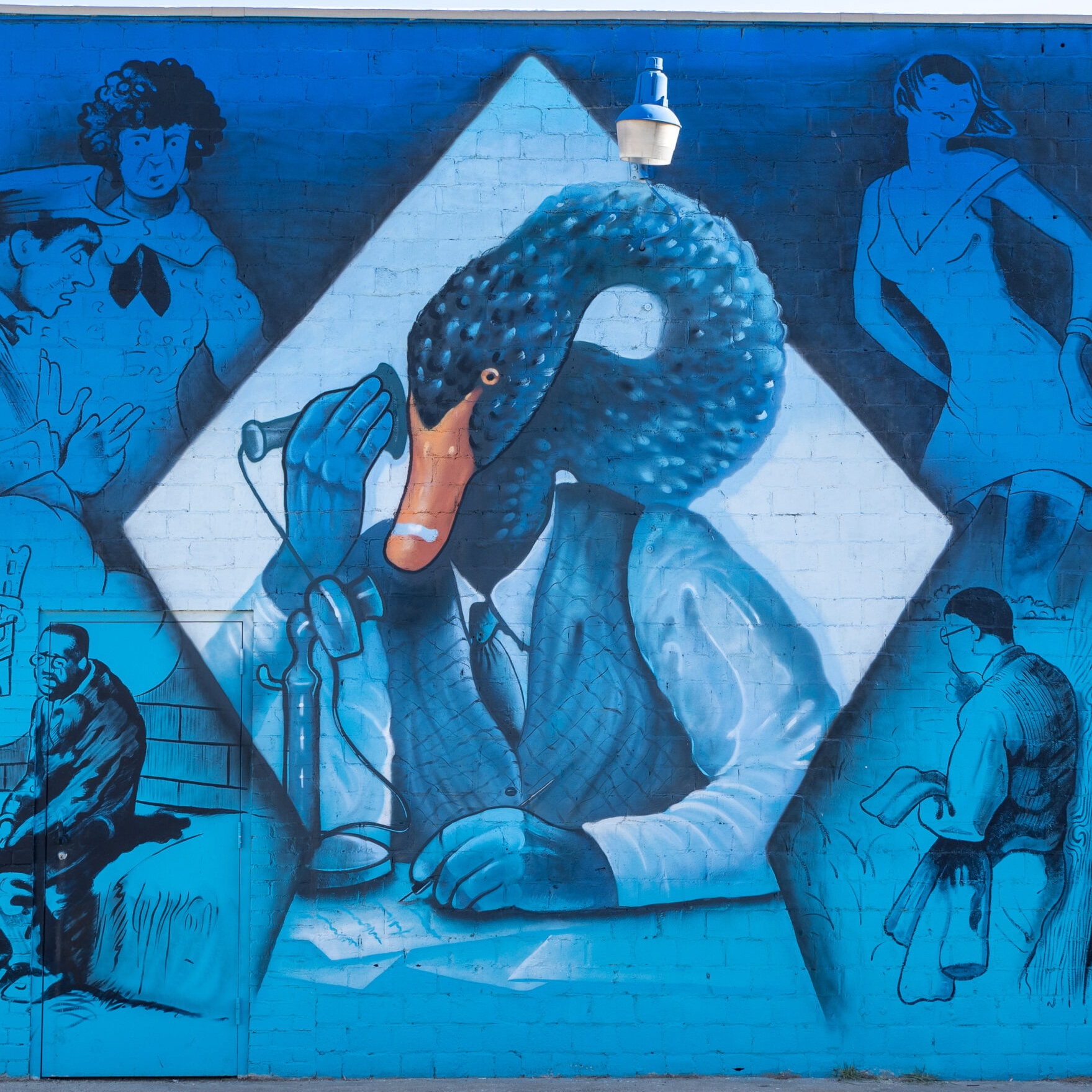
Black Swan
by JD Moore
Deep Ellum’s blues sound reached and inspired the nation and then the world from the early 1920s and on.
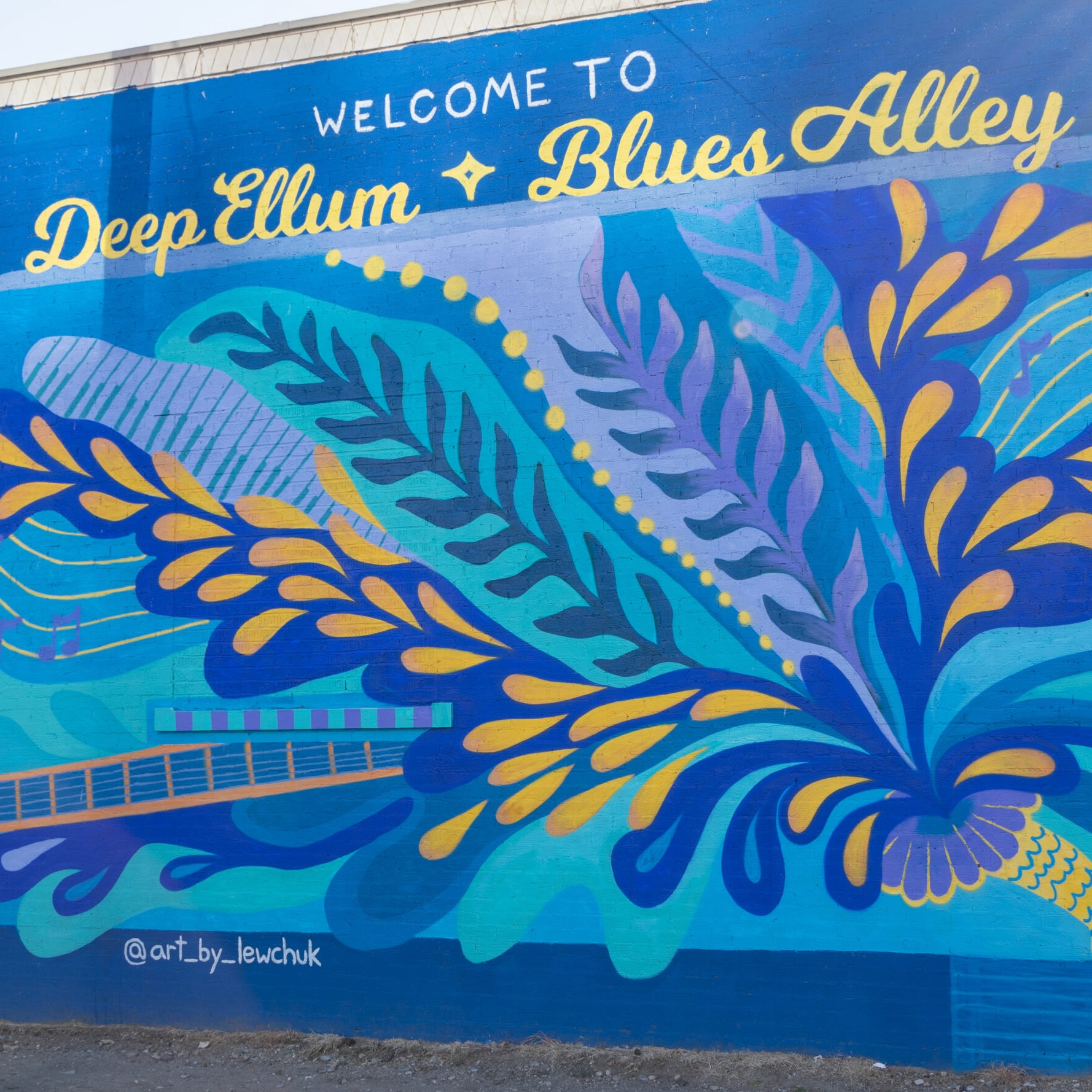
Welcome to Blues Alley
by Lauren Lewchuk
Lauren Lewchuk @art_by_lewchuk | Clover Street & South Crowdus Street
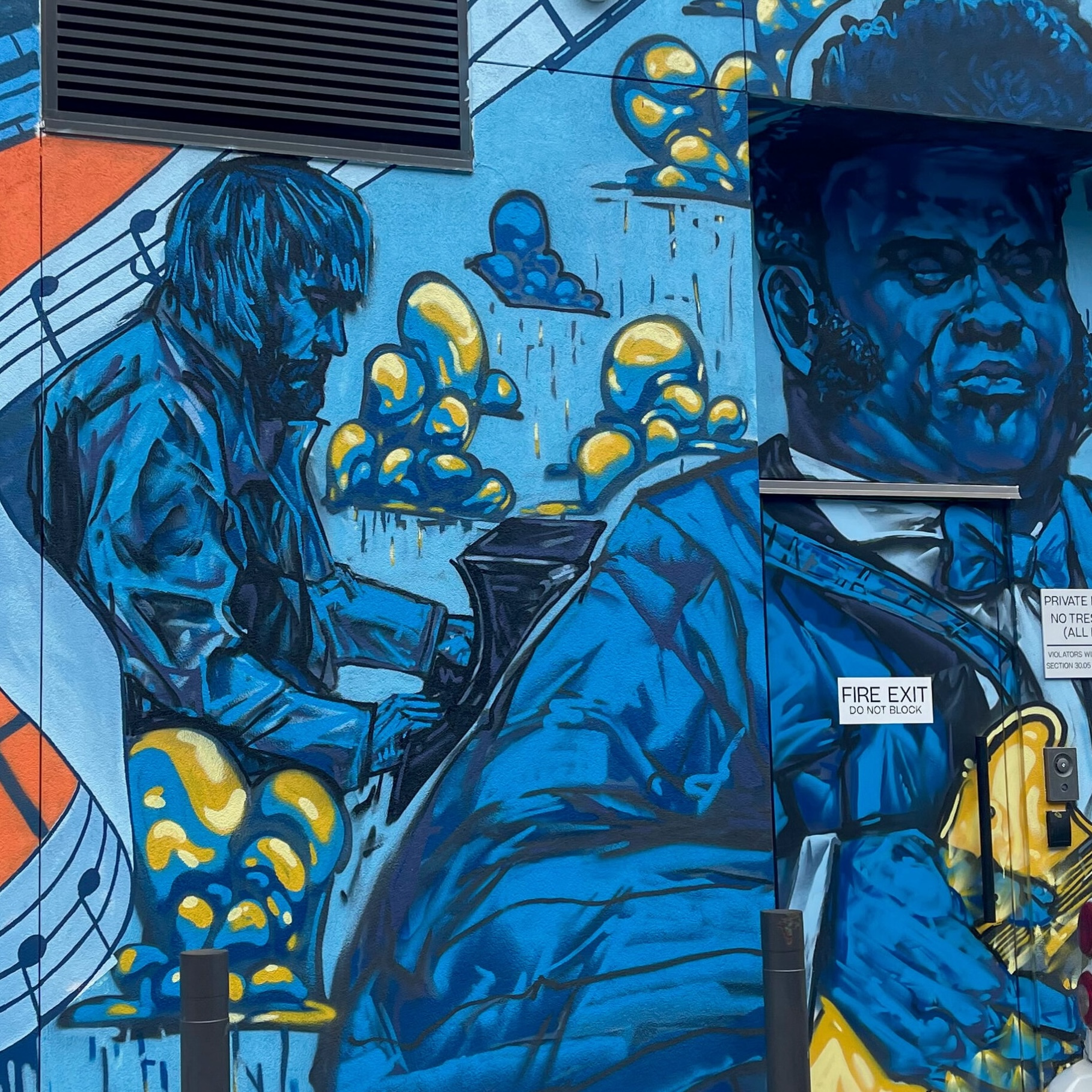
"The Texas Cannonball" Freddie King and Lewis Stephens
by Alec DeJesus
Alec DeJesus @youcancallmealec | Clover Street & Henry Street

Ray Charles
Sanah Brown Bowers @sanahbrownbowers | Clover Street & South Crowdus Street

Wanda King
Lashonda Cooks @shondasart | Clover Street & South Malcolm X Blvd.
“Wanda King is a force. Her voice. Her candor. Her majesty as she leads her band -- she's one of few female bandleaders. Her passion for preserving the blues while creating space for newcomers and updated interpretations," Cooks says. The muralist worked with King over phone and email to capture her power, beauty and passion in the mural. It references one of King’s favorites, a fantastic photo by acclaimed photographer David Lagford of her singing and leaving it all on stage: Everything else melts away. “That's my goal. To translate that incredible photo into paint and bottle the pain, the presence and span of the human experience in all its joys and struggles in her image.”

Ma Rainey
Michelle Dekkers | Clover Street & South Malcolm X Blvd.
When people discuss the birth of blue music, and more specifically Deep Ellum blues, the first and sometimes only names mentioned are those of men. Through art, we can tell the stories of those female powerhouses who stood alongside those men and helped pave the foundation of blues music that we know and love today. This wall is an homage to the “Mother of the Blues,” the formidable Ma Rainey. Born in 1886, Gertrude “Ma” Pridgett began her career in her early teens and recorded her first songs in 1923, only three years after the first Black woman was recorded. The design includes classic 1920s patterns and an iconic 1920s microphone at the forefront to set the stage for the era she reigned. The silhouettes of male musicians represent her backing band and are intentionally faded into the background to keep the focus on Rainey as the star. Some of Ma’s lyrics referenced lesbianism and bisexuality, which was another way she paved a new path of expression and went against the grain. As a nod to her gender-bending boldness, her headpiece and flapper dress have the Bi and Lesbian Pride flag colors incorporated.

"Mo'Betta Blue" Boom Box Graphic
Ebony Lewis @ebonylewisart | Clover Street & Henry Street
This work speaks to the transition and evolution of blues music and how its influences are still relevant to this day. It traverses generational gaps, which is why the artist incorporated the more modern boom box stereo. Within the piece you will spot an owl, which represents wisdom and pays homage to artists of the past. All the while, the youthful young man is looking forward to the endless, forever evolving possibilities music has created for all people. Especially for people of color, blues music has been a tool to give people hope despite trials and tribulations.

Sam Meyer
Frank Campagna | Clover Street & South Crowdus Street
Local musician Sam Myers was the recipient of nine W.C. Handy awards. He played drums for Elmore James from 1952 to 1963, including on the hit "Dust My Broom." George Harrison of The Beatles gave Elmore a shout out on their song "For You Blue," to give an idea of how influential the James/Myers contribution to music has been. Outside of this, Sam is best know for writing "Sleeping in the Ground," a song covered by Blind Faith, Eric Clapton and Robert Cray, among many other blues greats. Muralist Frank Campagna was able to know Sam by hanging at the long defunct nightclub/blues bar Schooners in the 1990s, where Myers was a regular performer and celebrity. Due to extremely poor eyesight, he would challenge anyone who walked into the darkness of this club by breaking out his Zippo lighter. Sometimes a cold beer was on the line but no matter, he always had the biggest brightest flame, and it worked as a great conversation starter to spend time with this legend.

Pattern
Brandon Ephraim Berrios | Clover Street & South Crowdus Street
Berrios's work has designs in harmony with a large mandala with an abstract pattern in background.

"Big Night Blues" A Blind Lemon song depicted
Hatziel Flores @hatziel | Clover Street & Henry Street
This mural aims to capture the night life of Deep Ellum described by Lemon Jefferson's song "Big Night Blues." The mural captures a wonderful night dancing past midnight, feeling the vibes coming from the venues and everyone having a great time. Music is the biggest part of making that happen.

"Triadic Triblu” African fabric-inspired pattern
Jody Aderhold | Clover Street & South Crowdus Street
This is a modern twist on a tribal pattern, with the blue triangle pattern creating a dynamic backdrop while telling a story of history through pattern.

"Jam Session" Andrew "JrBoy" Jones, and Zuzu Bollin
Hatziel Flores (Jones), Ray Albares (Bollin), Joe Skillz (pianist) @hatziel / @albarez / @joeskilz52 | Clover Street & South Crowdus Street
This mural is a jam session, both for the artists depicted and the artist who painted them. It's a group coming together, each using their own style to create magic together.

Erykah Badu
Dan Colcer @dcolcerart | Clover Street & Henry Street

"Of Ellum" Aaron T-Bone Walker, Jimi Hendrix, Leon Bridges
Alfredo Pina @1amthewalrus | Clover Street & Henry Street
"Of Ellum" is an homage to all the blues musicians tied to Dallas and Deep Ellum and the vast influence they’ve had worldwide. It depicts T-Bone Walker at left (aka Oak Cliff T-Bone). He is the first to ever play blues with electric, even playing behind his head and with his teeth. He’s a legend and inspired Jimi Hendrix and BB King among many others. Jimi Hendrix took that Dallas swag and became an icon larger than life, mixing rock and blues seamlessly. At right we have Leon Bridges from Fort Worth. His soulful approach to music and his unique style makes him a pioneer in his own right, but you can hear the past woven into his sound.

Lightnin Hopkins
Dan Colcer @dcolcerart | Clover Street & Henry Street
The opener of the Blues Alley, Texas Sam Lightnin’ Hopkins sits in the starting position of the murals at the back of the Stack building. He was born in 1912 in Centerville, Texas, and raised in the state. He rarely played outside Texas and was known for his unique style with tapping, slapping and playing both melodic and harmonic sides of the songs with his guitar. He became one of the most iconic representatives of the Texas Guitar Blues and was known for his comic additions of storytelling that often introduced his songs. Sam Lightnin’ Hopkins' body metamorphosizes into the treble clef that starts the music sheet. The ribbon of the staff starts at this point and travels, undulating, through the entire back wall of the Stack Building, travelling through each of the muralists’ pieces. The song can be read as the melody lines to “Deep Ellum Blues” (in E#, as performed in a rendition of the classic blues song the Grateful Dead often performed).

Lonnie Johnson
Jerod Davies @dtoxart | Clover Street & South Crowdus Street

Whistlin' Alex Moore
Martell Holloway @artbymartell | Clover Street & South Crowdus Street
"Dallas artist ""Whistlin"" Alex Moore was an American blues singer, pianist and whistler. His odd style of performing became well known internationally. As the piano was his main instrument, he occasionally whistled to add a unique flare to his music. The elements of the staff and keys flows within the mural to resemble the notes he'd whistle while playing the piano. "

Musician walking down the Central Track to Dallas
Cathryn Colcer | Clover Street & Henry Street
The piece includes the Blues Alley logo at the top. Dan Colcer’s stylized trees and sky loom over a darkened view of a 1930s Dallas skyline and of a blues man busker carrying his guitar and walking on the train tracks toward Deep Ellum. The Central Track, or the crossing point between the Houston and Pacific and the Santa Fe rails, is critical to the story of the neighborhood’s existence.

Blackland Prairie
Mari Pohlman @marpohl | Clover Street & Henry Street

“N'Dambi Blue”
Izk Davies @izkart | Clover Street & South Crowdus Street
The mural of N’Dambi is an ode to the incomparable rhythm and blues from Dallas. We have so many talented artists who went on to international recognition and deserve to be highlighted. N’Dambi’s album “Little Lost Girl’s Blues” was pure inspiration from the moment the muralist heard it.

"Mance Lipscomb
Daniel Yanez @artistdiy | Clover Street & South Crowdus Street
Yanez uses color and patterns to highlight Blues Player Mance Lipscomb. His strong facial features caught Yanez's attention when he was first introduced to his music, and he knew he had to make that the key component in the piece. He worked to highlight the person more than the music with the use of energetic patterns that help tell his story. Yanez feels blues is a feeling that is expressed by life experiences and telling stories of those experiences through music, and he attempts to do the same through paint.

"Life by the Drop" Jimmy Lee and Stevie Ray Vaughn
Ryan Stalsby @ryan_stalsby_art | Clover Street & Henry Street
Life by The Drop is a mural honoring Dallas-born blues musicians and brothers Jimmie Vaughan and Stevie Ray Vaughan. The mural depicts the two brothers rising out of old polaroid picture frames set in front of a downtown Dallas view looking west from Deep Ellum. The old steam engine train represents the Central Track, where the worlds of many people of different ethnicities met. The ominous clouds rolling in on either side with the lightning and rain falling signify the feeling of the blues and correlates to Stevie’s album, “the Sky is Crying,” which was released in 1991, 14 months after Stevie Ray Vaughan’s untimely death. The title of the piece, “Life by The Drop,” is a homage to the late great Doyle Bramhall, Dallas native musician and long-time friend of Jimmie and Stevie.

Cactus Royal Garden
Will Heron | Clover Street & South Malcolm X Blvd.
Reflecting on his Dallas roots, Will Heron's work often fuses southern imagery and shape illusions to create prickly, illustrative, high-contrast compositions. His minimalistic approach to design in both gallery and mural works, opens the dialogue between the worlds of illustration and street art. His cactus imageries explore larger concepts throughout his bodies of works including dichotomies in nature, resilience from brokenness, and physical/metaphorical growth.

Musical Pattern
Dora Reynosa @byzeneth | Clover Street & Henry Street
Reynosa created a man who is deconstructed to an extent. He is merged in with music instruments with a colorful range of blues. This represents the embodiment of music and art, and how embedded we become with out crafts as artists.

Henry Qualls
Selena Mize @selenammize | Clover Street & Henry Street
"Selena Mize was told Henry Qualls was never without his guitar, and she used a couple of images from online resources to piece together a design of him playing his guitar. The above-waist figure is positioned in the center of the wall, facing to the right. His profile gazes outward toward the rest of Blues Alley with a very humble, yet stoic, facial expression as he holds his beloved instrument. Other characteristic elements Henry Qualls wore, such as a firestone beanie and a plaid flannel, are included. To invoke movement, he is enveloped in bright orange delineations that make up triangular, geometric shapes as they stack on top of each other uniformly. The shapes extend to just above his chin, and almost resemble the points of mountains. They overlap behind and in front of the figure to help break up the different shades of blue and provide a dashing pop of color."

Bessie Smith
Dan Colcer @dcolcerart | Clover Street & Henry Street

Chadwick Murray
Haylee Ryan @hayleeryan | Clover Street & South Malcolm X Blvd.
Ryan painted her dear friend, band mate, local musician and all around good person, Chadwick Murray, who passed away Sept. 1, 2021. He grew up here playing music and marinating in the streets of Deep Ellum, playing in places such as Muddy Waters and bouncing from blues jam to blues jam. Besides playing music, he was also a well-known security guard at places such as the Green Room, Copper Tank and others. Chadwick's grandfather even used to spend time in Deep Ellum. His voice, music and laugh run through the streets of Deep Ellum.

Johnny Winter
Frank Campagna | Clover Street & South Malcolm X Blvd.

Blues You Can Feel but Not See
Teal Suns @tealsuns | Clover Street & Henry Street
This mural is a double portrait of Texas Blues Artists Blind Lemon Jefferson and Blind Willie Johnson. Although they weren’t a duo, they shared a passion to create despite physical setbacks. In a city full of all sorts of artists at different points in their journeys, the artist felt it was important to depict true creators who practiced such determination with their crafts.

Black Swan
JD Moore @jdmooreportfolios | Clover Street & South Crowdus Street
Deep Ellum’s blues sound reached and inspired the nation and then the world from the early 1920s and on. A key figure in the export of Dallas’ sound was businessman/entrepreneur R.T. Ashford. Ashford owned a music shop advertised in the Dallas Express as The Black Swan Music Shop, which distributed paramount records (not affiliated with Paramount movie studios). Ashford's relationship with the record company was the key that turned Blind Lemon and the now lesser known, but nationally acclaimed blues singer Lillian Glinn into signed recording artists. Ashford is himself a black swan, given all of his accomplishments growing up in the Jim Crow South. Finding no portraits of him online, Moore decided to depict him as just that, a black swan. The illustrations used in newspaper ads also played a role in gaining interest and giving the music they accompanied, a visual identity. Moore feels they helped describe the events and experiences that inspired the musicians to create their songs.

Welcome to Blues Alley
Lauren Lewchuk @art_by_lewchuk | Clover Street & South Crowdus Street
Lewchuk's primary inspirations for her work are nature and music, and so for her Blues Alley concept, she created a design full of detailed and organic elements along with some abstract instrumentation, which can be seen as a visual representation of music itself. This elaborate design created with plenty of musical undertones set inside of an archway/stage will be seen as a focal point and entrance to Blues Alley.

"The Texas Cannonball" Freddie King and Lewis Stephens
Alec DeJesus @youcancallmealec | Clover Street & Henry Street
This mural featuring Freddie King and Lewis Stevens aims to honor the impact they had on blues. I personally resonated with his legacy, because King left Chicago to pursue his passion in Dallas, where he would craft a legacy that would ripple through the blues world for generations to come. The artist worked to capture the strong soulful feel of his voice by having him surrounded by glowing storm clouds in an attempt to show him lost in his craft. The sparks from his hands show just what energy he had when playing his guitar. His keyboardist, a still-living legend, is displayed behind him also giving a nod to the fact that Freddie king was the first African American blues musician to have a white musician backing him up. He was a powerful presence who broke down barriers with his music.
